
Influential scientist, activist and author Dr Vandana Shiva has spent decades fighting to protect biological and cultural diversity. Everett Collection Inc/Alamy Stock Photo
I could tell you that, around the world, three people are killed every week while trying to protect their land, their environment, from extractive forces. I could tell you that this has been going on for decades, with the numbers killed in recent years hitting over 200 each year. And I could tell you, as this report does, that a further 200 defenders were murdered in the last year alone. But these numbers are not made real until you hear some of the names of those who died.
Marcelo Chaves Ferreira. Sidinei Floriano Da Silva. José Santos López. Each of them a person loved by their family, their community. Jair Adán Roldán Morales. Efrén España. Eric Kibanja Bashekere. Each of them considered expendable for the sake of profit. Regilson Choc Cac. Ursa Bhima. Angel Rivas. Each killed defending not only their own treasured places, but the health of the planet which we all share.
It's important to picture these victims as the real people they are. It’s easier for me. I have been surrounded by land and environmental defenders all my life, and indeed I am one of them. It started for me in the Garhwal Himalaya in India, where my father was a forest conservator and my mother a farmer. Industrial logging was destroying the ecosystem in which we as humans were intertwined. We knew, intimately, that the value of the Himalayan forest was not to be found in the price of its timber, but in the way its extraordinary, abundant diversity sustains all forms of life – not least our own. And so we put ourselves in the way of the commercial deforesters.
By doing so, we weren’t just putting ourselves in danger. We were confronting a whole viewpoint – a way of seeing nature as something not to be cherished and protected, but to be conquered and subdued. This is a viewpoint with its roots in the Western industrial revolutions of the 19th century, or even further back in the scientific theory of the Western so-called ‘Enlightenment’. It matters that this viewpoint originated in the West. As this report shows, nearly all of the murdered environmental and land defenders are from the Global South, and yet it is not the Global South that reaps the supposed economic ‘rewards’ of all this violence.
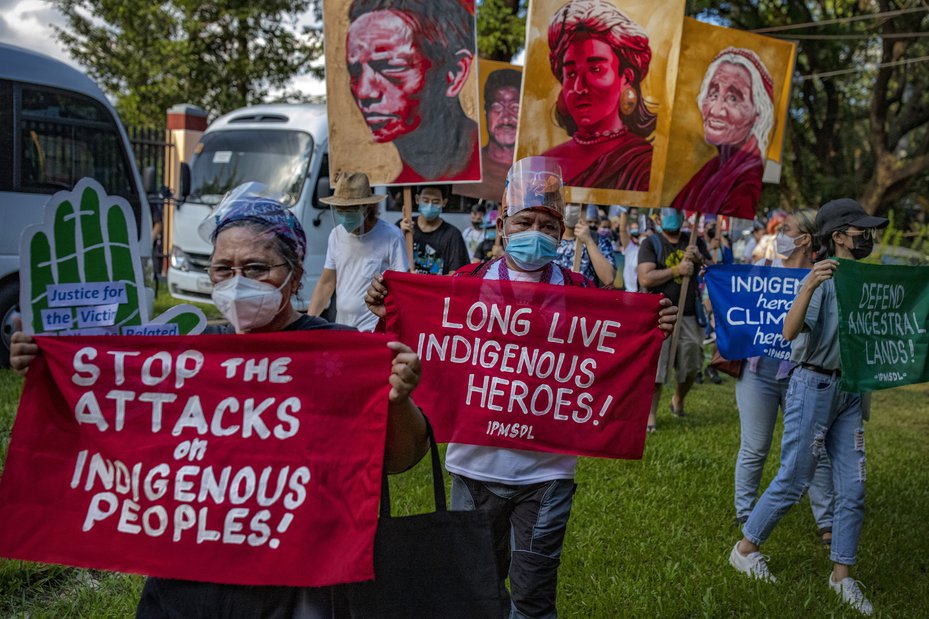
Climate activists hold up signs next to portraits of slain Philippine environmental defenders as they take part in climate justice protests on November 06, 2021 in Quezon city, Philippines. Ezra Acayan/Getty Images
The final, saddest truth is that this viewpoint has brought us to the brink of collapse. We are not just in a climate emergency. We are in the foothills of the sixth mass extinction, and these defenders are some of the few people standing in the way. They don’t just deserve protection for basic moral reasons. The future of our species, and our planet, depends on it.
That’s why it’s so important to support the call, made in this report by Global Witness, for real protections to be afforded those on the frontline of this ecological and humanitarian catastrophe. These are the people who understand, at the most fundamental level, how the fate of humanity is entwined in the fate of the natural places they are defending. It’s why they are prepared to risk everything to defend these places. And it’s why they, more than anyone, deserve protection.
That means national and supranational governments committing to report and investigate these murders, and ultimately to serve justice on the culprits. It means governments ensuring protections for defenders, including reporting and investigating their murders as a means to access justice. It means companies ensuring their operations do not cause harm. And of course it means all of us continuing to shine a light on these stories, not just to remember those who have fallen but to continue their urgent work by telling the world exactly why they are dead.
In 2021, 200 people were killed protecting their homes and their rights. I urge you to read all their names. To honour the dead with your attention. To get angry on their behalf, and then to act.
Message from our CEO, Mike Davis
Almost exactly ten years ago, I was in a meeting at our office in London. A colleague came and called me out of it to give me a message. But she was struggling to form the words she wanted to say. I became worried. When the words did come, I learned that one of my former colleagues in Cambodia – a member of the team I was part of there some years before – had been killed.
That former colleague was a man called Chut Wutty. When he and I worked together in Cambodia, he was investigating illegal logging. When we closed our office – because of threats to our local staff relating to their efforts to protect forest defenders – Wutty went on to form his own organisation. He had also become – unexpectedly – a leader to community activists trying to protect their forests, which were also their homes and their livelihoods. Now Wutty was dead, hit by a bullet fired during a confrontation with members of the security forces and guards employed by the company he was investigating for illegal logging and land seizures. The government swiftly embarked on a cover-up.
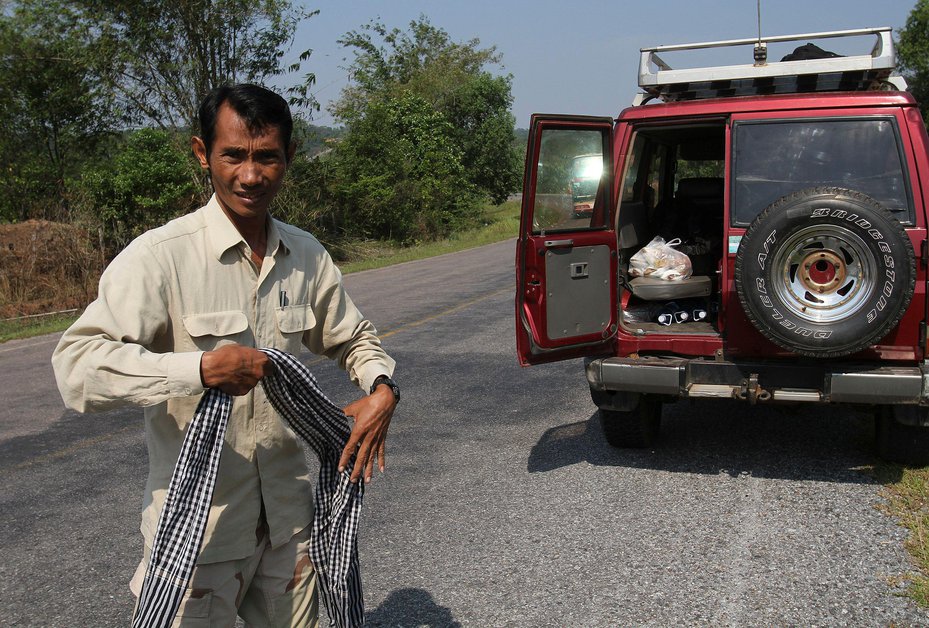
Chut Wutty walks in Koh Kong province. Wutty, a prominent Cambodian anti-logging activist who helped expose a secretive state sell-off of national parks was fatally shot on April 25, 2012 in a remote southwestern province. Reuters/Alamy Stock Photo
While we at Global Witness were familiar with the targeting of our partners as they were defending their land and environment, the murder of our former colleague, Wutty, prompted us to confront a range of questions. What was the global picture, what were the implications of such attacks and what could be done to prevent them?
All over the world, Indigenous peoples and environmental defenders risk their lives for the fight against climate change and biodiversity loss. Activists and communities play a crucial role as a first line of defence against ecological collapse, as well as being frontrunners in the campaign to prevent it. This report aims to share reflections on how we think about these questions now – ten years on from Wutty’s death – and makes an urgent appeal for global efforts to protect and reduce attacks against defenders.
This report, and our campaign, is dedicated to all those individuals, communities and organisations that are bravely taking a stand to defend human rights, their land, and our environment. 200 of them were murdered in 2021 for doing just that. We remember their names, and celebrate their activism.
| Argentina | Elías Garay |
| Bolivia | Lino Peña Vaca |
| Brazil | Aldenir dos Santos Macedo |
| Alex Barros Santos da Silva |
| Amaral José Stoco Rodrigues |
| Amarildo Aparecido Rodrigues |
| Ângelo Venicius Henrique Mozer |
| Antônio Gonçalves Diniz |
| Eliseu Pedroso |
| F.S.S. |
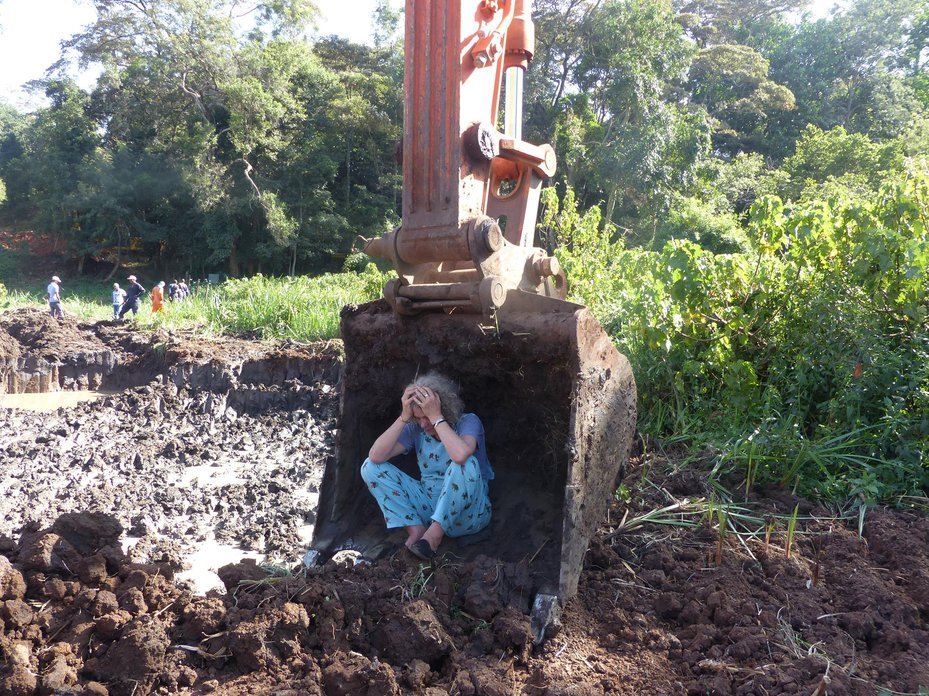
Environmental activist Joannah Stutchbury attempting to defend the Kiambu forest in Nairobi, Kenya from a developer. Joannah Stutchbury/Facebook
Joannah had tree sap running through her veins. She was a tree lover, a permaculture practitioner, a full-on environmentalist and conservationist, a mum and an earth mother. She had an ardent and unwavering passion for the planet, and was wonderfully bonkers. She was full of life and joie de vivre. She was shot dead as she returned to her home on the outskirts of Nairobi in Kenya in July 2021.
For many years Joannah had spoken out with passion and determination against land-grabbers and well-known private developers who had begun destroying the Kiambu forest next to where she lived. She made headlines in 2018 when she single-handedly confronted those that were felling trees and, in the months before she was killed, she had rightfully won a legal case against a developer wanting to build on the forested land.
On the day of the incident, she stopped her car to clear branches that had been purposefully put there to block her driveway. Neighbours found her dead with her car engine still running. I’m praying she didn’t see it coming and that she didn’t suffer, but it looks like this extraordinary woman was targeted to be murdered.
We also know she was receiving multiple death threats. One time, I recall her telling me that unknown men had visited her to tell her they would kill her if she continued disrupting their plans to construct an access road through the forest. Despite this, she received absolutely no police protection. But that didn’t stop her. She continued to fight for what she believed in. For what we should all believe in. Still to this day, her bravery and determination is what shines through all the sadness.
I often ask myself in despair – how many more environmentalists protecting our planet are going to have their life force ripped away before governments start paying attention and finally stand shoulder to shoulder with these brave pioneers? Legislation and enforcement are needed globally to hold accountable greedy corporates, corrupt authorities, thoughtless land grabbers and those whose very existence is propelled by indiscriminate blood money.
Joannah was an exceptional soul – a noisy, wonderful, troublesome woman on a mission to protect the world in countless ways. But she was also a normal, everyday person, just like you and me. She had no agenda other than living sustainably, sharing her knowledge, taking care of forests locally and worrying about the existential climate crisis. And she loved Mother Nature to the max. We will forever mourn what we and the world have lost.
Recommendations
The government of Kenya should:
- Ensure that those responsible for the murder of Joannah Stutchbury are brought to justice.
- Recognise the rights of Indigenous peoples and local tree-planting communities as a critical and effective way to protect forests, including the Kiambu Forest.
- Protect land and environmental defenders by ensuring effective and robust regulatory protection of the environment, land rights, Indigenous peoples’ rights, livelihoods and cultures, including to free, prior and informed consent.
- Withdraw the proposed Amendment Bill to the Forest Conservation and Management Act of 2016. The proposed amendment would weaken the governance mechanisms of Kenya’s public forests, open avenues for the grabbing of public forest land and lead to the loss of forests.
- In conjunction with discussions with Indigenous people and tree-planting communities, create an advisory panel that includes climate scientists, meteorologists and environmental NGOs. They can all contribute experience and share data about what lies ahead, as the blueprint to mitigate climate chaos and global warming is created.
Tracey West, CEO of Word Forest
200 land and environmental defenders were killed in 2021
Democratic Republic of Congo 8
Top findings – 2021
Global Witness recorded that 200 land and environmental defenders were killed in 2021 – nearly four people a week. These lethal attacks continue to take place in the context of a wider range of threats against defenders who are being targeted by government, business and other non-state actors with violence, intimidation, smear campaigns and criminalisation. This is happening across every region of the world and in almost every sector.
Mexico was the country with the highest recorded number of killings, with defenders killed every month, totalling 54 killings in 2021, up from 30 the previous year. Over 40% of those killed were Indigenous people, and over a third of the total were forced disappearances, including at least eight members of the Yaqui community.
Whilst Brazil and India both saw a rise in lethal attacks from 20 to 26, and from 4 to 14 respectively, both Colombia and the Philippines saw a drop in killings to 33 in 2021 from 65, and 19 from 30 in 2021 respectively. Yet overall they remain two of the countries with the highest numbers of killings in the world since 2012.
Over three-quarters of the attacks recorded took place in Latin America. In Brazil, Peru and Venezuela, 78% of attacks took place in the Amazon.
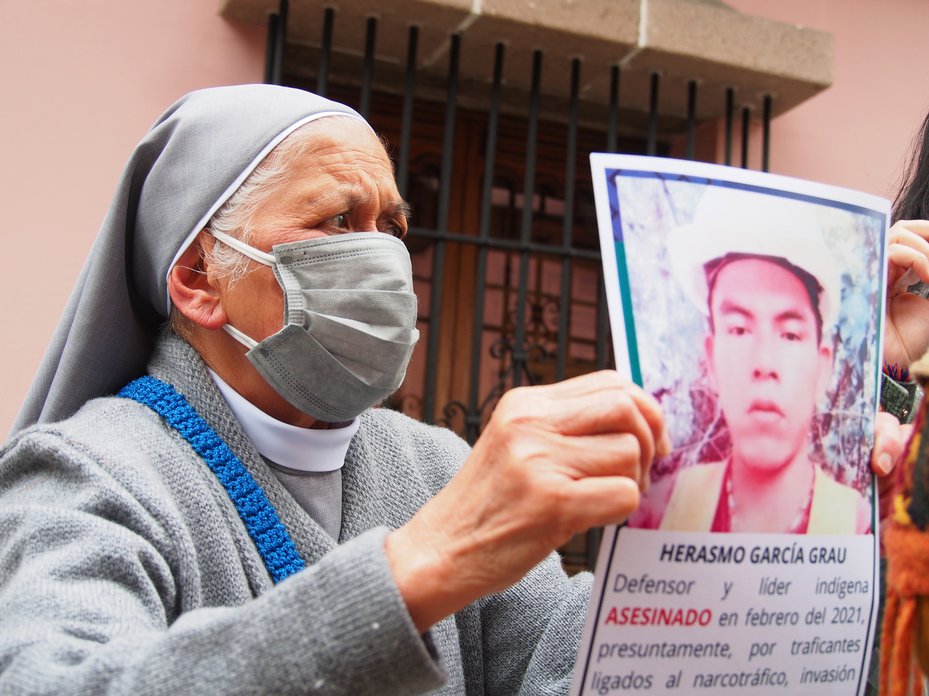
A nun holds a photo of Herasmo García Grau, a defender, as activists gather in Peru. Herasmo was kidnapped and killed by persons linked to drug trafficking, and illegal logging. Carlos Garcia Granthon/Fotoholica Press/LightRocket via Getty Images
Global Witness documented 10 killings in Africa. The Democratic Republic of Congo remained the country with the highest number of attacks – eight defenders were killed there in 2021. All eight of these killings were in Virunga National Park, which remains extremely dangerous for the park rangers protecting it. Verifying cases from across the continent continues to be difficult and it is possible cases are widely unreported.
Where a sector could be identified, just over a quarter of lethal attacks were reportedly linked to resource exploitation – logging, mining and large-scale agribusiness – and hydroelectric dams and other infrastructure. However, this figure is likely to be higher as the reasons behind attacks on land and environmental defenders are often not properly investigated nor reported on. In the majority of cases where a sector could not be identified, land conflicts were found to be a key driver of the attacks against defenders. However, in many cases the economic motives behind land-related violence are not reported. Mining was the sector linked to the most killings with 27 cases – with the majority of attacks taking place in Mexico (15), followed by the Philippines (6), Venezuela (4), Nicaragua (1) and Ecuador (1).
In 2021 the disproportionate number of attacks against Indigenous peoples continued once again, with over 40% of all fatal attacks targeting Indigenous people, despite them only making up 5% of the world’s population. These were documented predominantly across Mexico, Colombia, Nicaragua, Peru and the Philippines.
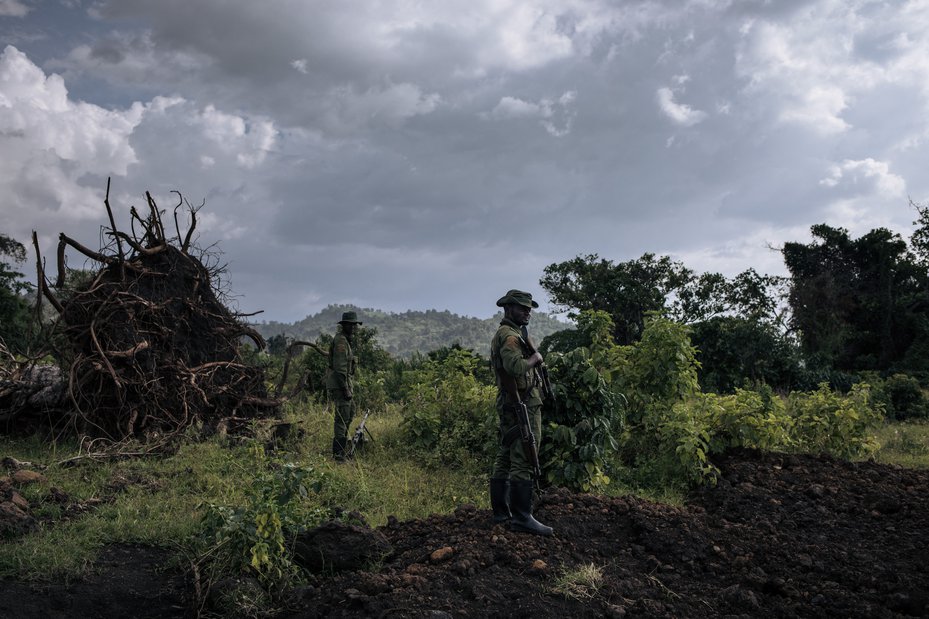
Virunga National Park guards stand guard in Rutshuru territory, north of Goma in eastern Democratic Republic of Congo on April 1, 2022. Eight Virunga park rangers were killed in 2021. Alexis Huguet/AFP via Getty Images
Global Witness recorded 12 mass killings, including three in India and four in Mexico. In Nicaragua, criminal groups massacred 15 Indigenous and land rights defenders as part of systematic and widespread violence against the Miskitu and Mayangna Indigenous peoples.
50 of the victims killed in 2021 were small-scale farmers, highlighting how the relentless commodification and privatisation of land for industrial agriculture is putting small-scale farmers increasingly at risk as land deals ignore local tenure rights. Small-scale family agriculture, on which most of the world's rural poor still depend, is threatened by large-scale plantations, export-led agriculture and the production of commodities over food.
Around 1 in 10 of the defenders recorded killed in 2021 were women, nearly two-thirds of whom were Indigenous.
Gender-based violence rooted in misogyny and discriminatory gender norms is disproportionately used against women environmental and human rights defenders to control and silence them, and suppress their power and authority as leaders.

Compostela Farmers Association chair Noli Villanueva is in hiding following the killings of five of his colleagues by unidentified gunmen after protesting the entry of AgPet mining in Compostela town. Global Witness
Escazú Agreement
On 22 April 2021, the ‘Regional Agreement on Access to Information, Public Participation and Justice in Environmental Matters in Latin America and the Caribbean’ – also known as the Escazú Agreement – entered into force. It is the first regional environmental and human rights treaty in Latin America and the Caribbean, and the first legally binding instrument in the world to include provisions on environmental defenders.
The Escazú Agreement guarantees the right to access environmental information and participate in environmental decision-making. Most significantly, it also requires states to prevent and investigate attacks against environmental defenders. At the time of writing, key countries that are dangerous for defenders, such as Brazil and Colombia, have not yet ratified the Escazú Agreement, while others such as Mexico – which have ratified it – are yet to effectively implement it.
Mexico
For the third year in a row, Global Witness documented an increase in lethal attacks in Mexico – 54 defenders were killed in 2021, almost half of them Indigenous people. Conflicts over land and mining were each linked to two-thirds of lethal attacks. Around two-thirds of the killings were concentrated in the states of Oaxaca and Sonora, both of which have significant mining investments.
The country has risen rapidly over the last ten years as one of the most dangerous places for land and environmental defenders, with 154 documented cases over this period. The majority of killings (131) took place between 2017 and 2021 alone.
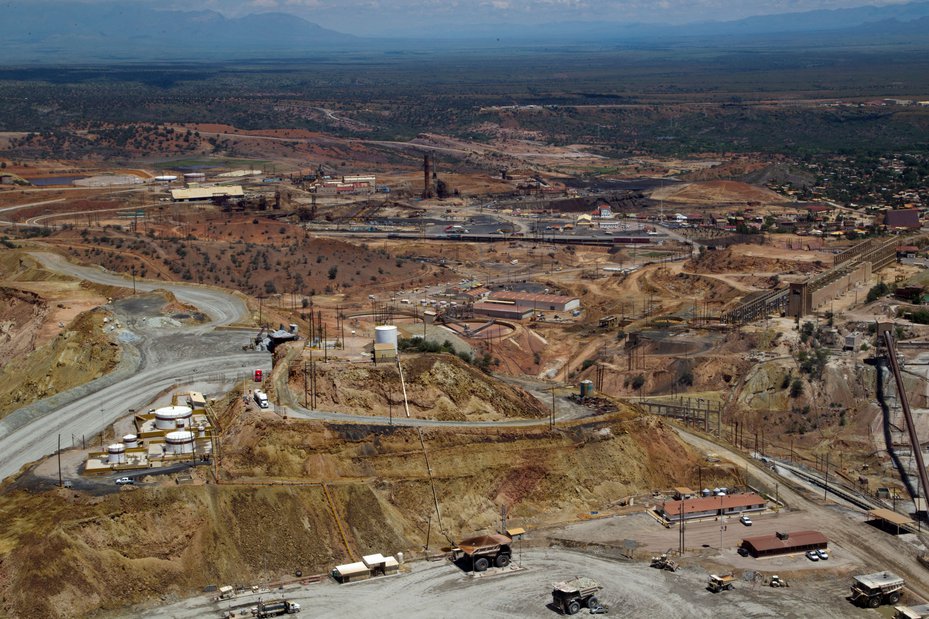
View of the "Buena Vista" copper mine in Cananea community, Sonora state, Mexico. Operations began in the 1970s and for decades have been linked to serious violence, human rights abuses and pollution. Hector Guerrero/AFP via Getty Images
Forced disappearances are common – Global Witness recorded 19 in 2021. They are carried out by corrupt state officials and organised criminal groups, and send a chilling effect through families and communities. In September 2021, officials discovered six sets of human remains near Yaqui territory in southern Sonora, Mexico, suspected of belonging to some of the ten men who disappeared in July. Following multiple disappearances and murders in the Yaqui community last year, officials stated they believed drug cartels were responsible. Some in the community, however, said they also suspect the government and corporations interested in Yaqui land and resources of being involved.
Indigenous territories are highly vulnerable to the prolific number of large-scale extractive projects promoted by national and foreign companies and backed by the Mexican government. The Inter-American Commission on Human Rights has raised concerns about the lack of adequate consultation with potentially affected communities and the subsequent attacks on those standing against signature projects. The Commission has flagged criminalisation and smear campaigns as harmful threats against land and environmental defenders in Mexico.
Impunity remains rife, with over 94% of crimes not reported, and only 0.9% resolved. Mexican environmentalist Irma Galindo Barrios disappeared in October 2021. Since 2018, Irma had faced intimidation by public officials, as well as harassment, persecution, defamation campaigns and death threats as a result of her defence of the forests. This defence included her submission of a formal complaint to the Ministry of the Environment and Natural Resources.
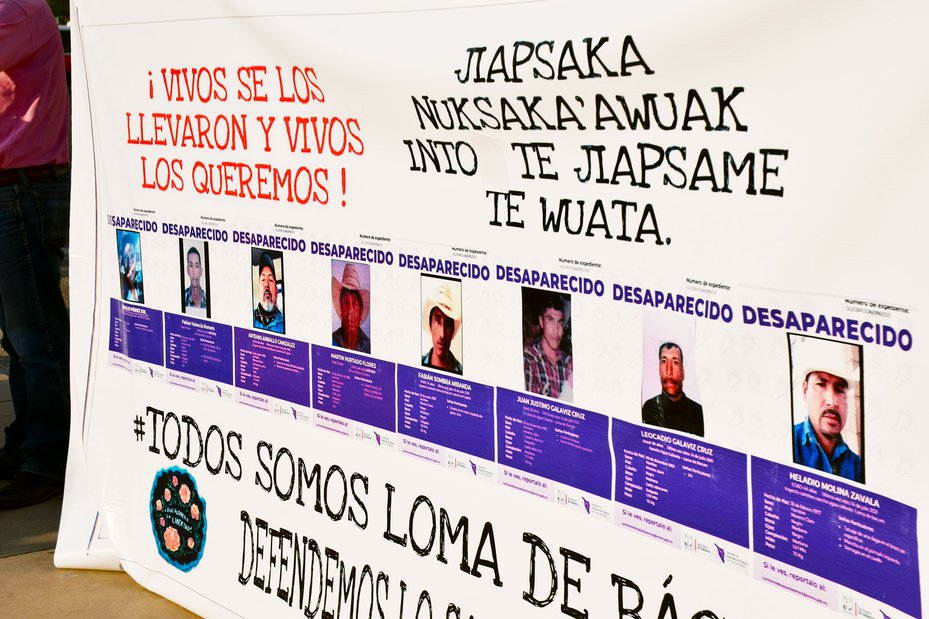
A local banner showing the photos of eight members of the Yaqui Indigenous community in Sonora, Mexico, who went missing in July 2021. Kendal Blust/KJZZ
Whilst the Escazú Agreement was ratified by Mexico in January 2021 and came into force in April, there is little state capacity or budget to support defenders, narrowing the likelihood of individuals and communities securing access to justice and redress. The Mexican Centre for Environmental Rights (CEMDA) has raised concern about the multiplicity of factors involved in this context of impunity, including the lack of compliance with human rights standards when investigating crimes against defenders.
Colombia
2021 was another dramatic year in Colombia, which continues to have one of the highest number of killings in the world. At least 33 land and environmental defenders were killed there last year. 2021 also marked the fifth anniversary of the peace agreement, which put an end to over 50 years of conflict with the Revolutionary Armed Forces of Colombia. Land disputes are a driving force behind the killings of land and environmental defenders, and the agreement acknowledges the need to address matters such as forced land displacement, unequal land tenure and the substitution of illegal crops by alternative legal crops. However, to date the implementation of the peace agreement has fallen short: peace is still a distant prospect for many Colombians, and the consequences of ongoing violence are particularly felt by the most vulnerable groups, including small-scale farmers and Indigenous peoples.
Sandra Liliana Peña was the respected governor of a Nasa Indigenous community and land in the Department of Cauca, one of the bloodiest areas in Colombia. She had openly opposed the growth of illegal crops and had been subject to multiple threats as a result. In April 2021, as she was getting ready to travel to the city of Popayán to meet local government officials, four armed men forced her out of her home and shot her dead.
Ángel Miro Cartagena was a small-scale farmer with a big dream: he wanted to be part of the transformation of land in the Department of Antioquia. He was actively contributing to a development programme aimed at producing high-quality coffee. Local militias are trying to take control of land in this area at any cost. He went missing in June 2021 and was found dead in a river. His body displayed signs of torture.
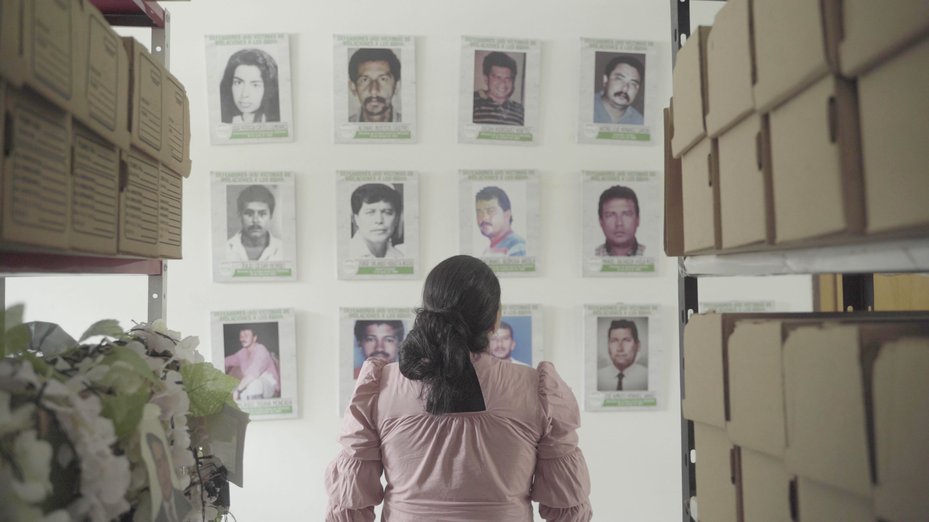
Yuli Velazquez, legal representative of environmental organisation FEDEPESAN looks at photos of local murdered defenders, Barrancabermeja, Colombia, 21 July 2022. Negrita Films/Global Witness
Brazil
Brazil saw a rise in reported lethal attacks from the previous year, representative of the wider threats land and environmental defenders face, particularly under President Bolsonaro’s rule.
Inflammatory rhetoric, a rejection of sustainability and failure to prosecute has flamed another epidemic, one of intimidation, attacks, and murder of human rights defenders.
Baskut Tuncak, UN Special Rapporteur on Toxic Waste, Brazil
In January 2021, Fernando Araújo, a landless rural worker and land rights defender from the Movimento Sem Terra was killed at his home on Santa Lúcia Farm in Pau D’Arco in the State of Pará. It is one of the most dangerous regions for human rights defenders in Brazil. Fernando had been a witness to and survivor of the largest massacre of rural workers in Brazil since 1996, the 2017 Pau D’Arco massacre, which resulted in ten rural workers being killed by the police on the Santa Lúcia farm. He was a key witness in the criminal case that followed. So far, no one has been charged or arrested for Fernando’s murder.
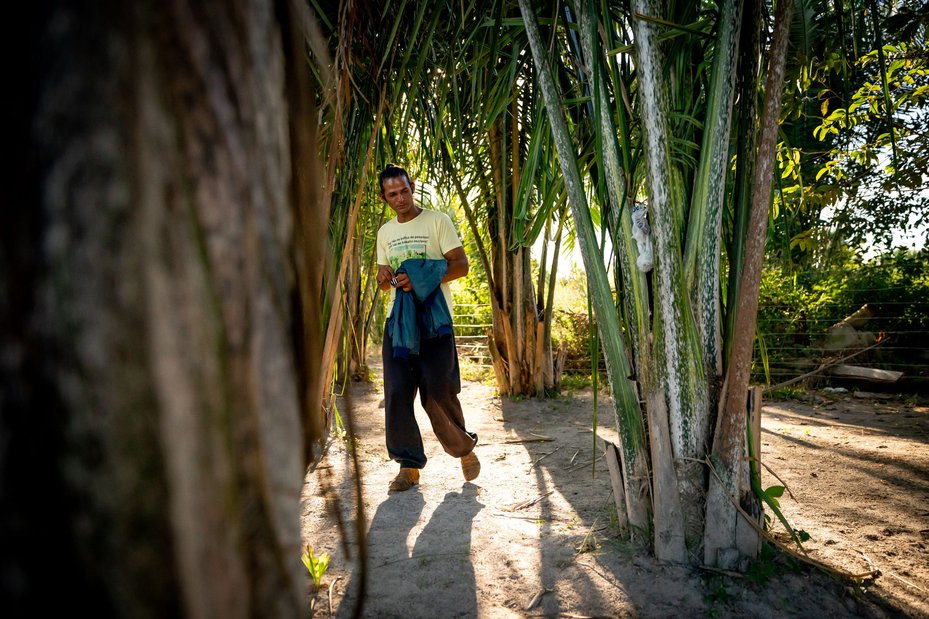
Fernando dos Santos Araújo walks through the site where police killed his boyfriend, Fernando Araújo, in January 2021, and friends in the Pau D'Arco 2017 massacre. Spenser Heaps
The following month, Isaac Tembé, a leader of the Tenetehara people was killed whilst out hunting with friends. The young Indigenous leader was shot point-blank in the chest, on his own land, by a member of Brazil’s military police. According to the Tembé-Theneteraha people, the country’s military police serve as private militias, defending the interests of farmers and ranchers that are illegally occupying areas of the Tembé Indigenous Territory. This case illustrates the blurring of Brazilian agribusiness and state-sponsored terror on Indigenous lands, which has significantly worsened under the Bolsonaro regime.
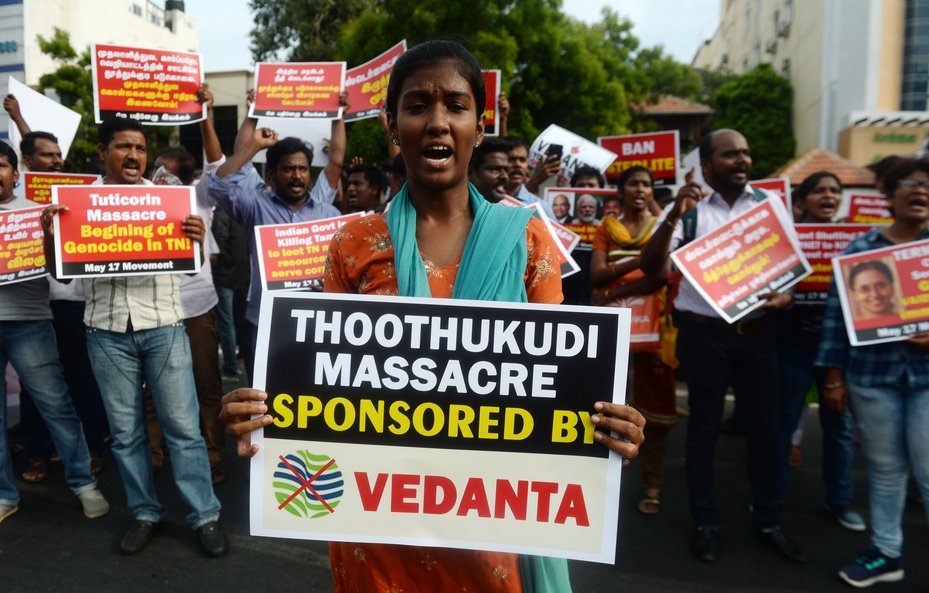
Indian protesters demonstrating against the killings of protesters in the Thoothukudi massacre, in Chennai on May 24, 2018. Arun Sankar/AFP via Getty Images
M.Karthi, an ardent social justice advocate, told his mother at around 10am on 22 May 2018 that he would be joining a protest on the streets in the nearby town of Thoothukudi in the southern Indian state of Tamil Nadu later that day. Climbing onto his motorbike, he was joined by his brother, friends Marimuthu and Murugesan, an acquaintance’s son, John, and around 15 others. He never returned home.
M.Karthi was killed along with 10 others in violence instigated by state police in Thoothukudi, which also resulted in injuries to more than 100 other people. People had gathered at the local district office to mark the hundredth day of peaceful demonstrations against copper smelting plant, Sterlite Copper, owned by Vedanta Limited. Residents wanted the plant closed down due to concerns about air and water pollution. The copper plant – already India’s second largest – had been preparing to double its expansion.
Eyewitness accounts, images and videos caught on camera, and media reports raise several disturbing questions about the modus operandi of the district administration and police. They were said to have attacked the demonstrators and resorted to firing live ammunition into the crowds. Despite Indian police rules on the use of force to quell protests, witness accounts tell of police snipers firing directly at protestors. The government claimed that the shootings were in response to the marchers resorting to violence. In the days that followed four more people lost their lives.
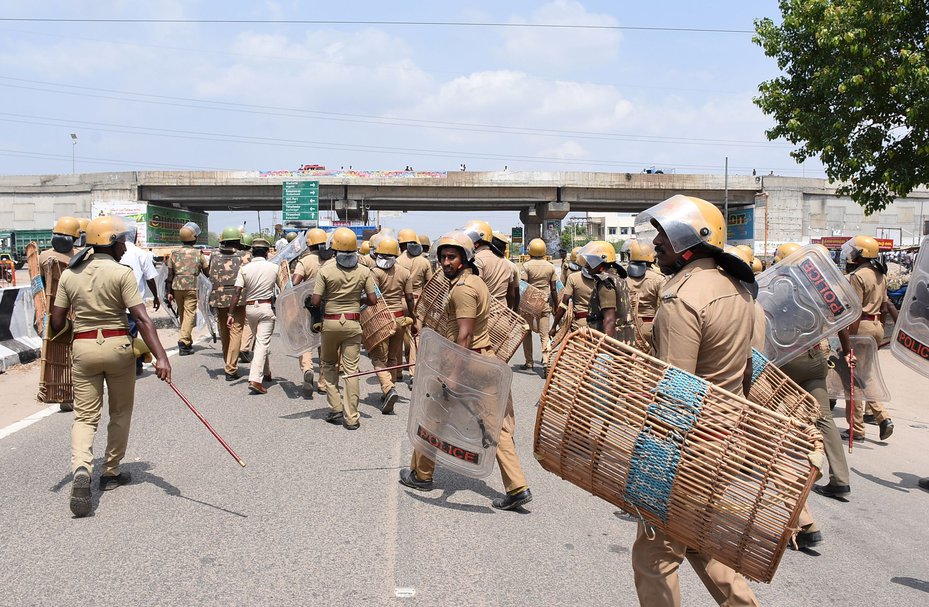
Indian police officials run towards protestors in the southern Indian city of Tuticorin on May 22, 2018, during a protest held to demand the closure of a copper factory owned by mining giant Vedanta. AFP via Getty Images
Following the protest, the government imposed an internet shutdown until May 25, limiting the flow of information from Thoothukudi. It also imposed Section 144 in the area – a colonial-era law restricting the public gathering of four or more people – until May 27.
After four years and several inquests into the killings, neither the state nor the company has been held culpable. What’s worse, CSOs and advocates campaigning for justice have since faced a myriad of human rights abuses, including criminalisation, surveillance, prevention of their right to assemble, threats and violence.
This is not the first time that Vedanta has been caught up in controversy in India. There have been myriad issues linked to its operations across the country, including in the eastern state of Odisha. Locals rallied to stop Vedanta from opening a bauxite mine that would have levelled a mountain they consider sacred and drive deforestation.The case wound its way through courts for more than a decade until the Supreme Court finally ruled against Vedanta in 2016, forcing the company to abandon the project.
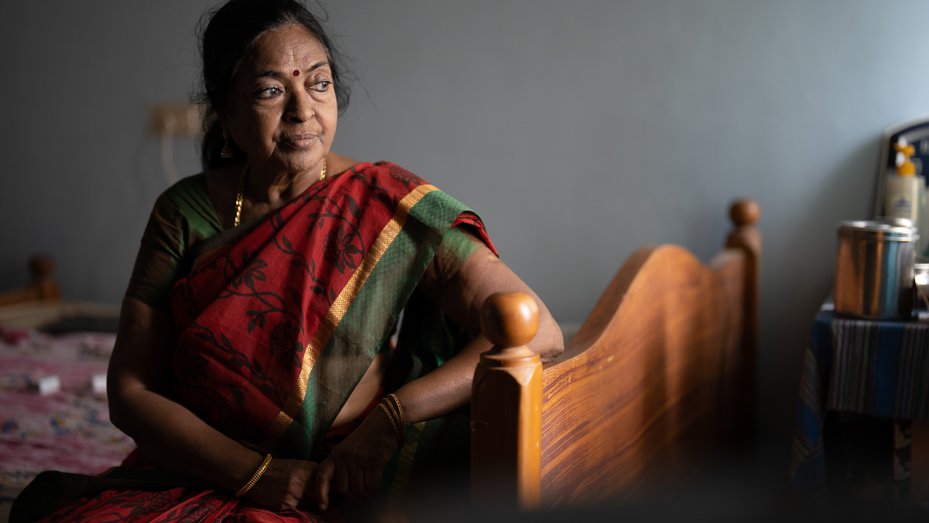
Environmental activist Fatima Babu at her house in Thoothukudi, India. Babu has led a decades-long campaign against copper smelting plant Sterlite, a subsidiary of Vedanta, over alleged contamination.
Alina Tiphagne/Global Witness
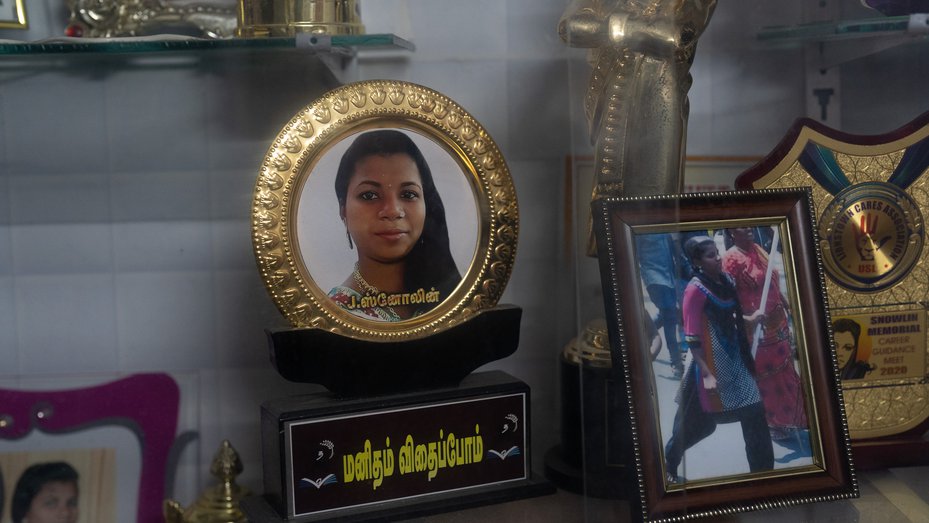
A photograph of 17 year old Snowlin marching on the day of the protest is on display at her house in Thoothukudi, India. Snowlin was killed during a protest against the copper smelting plant Sterlite.
Alina Tiphagne/Global Witness
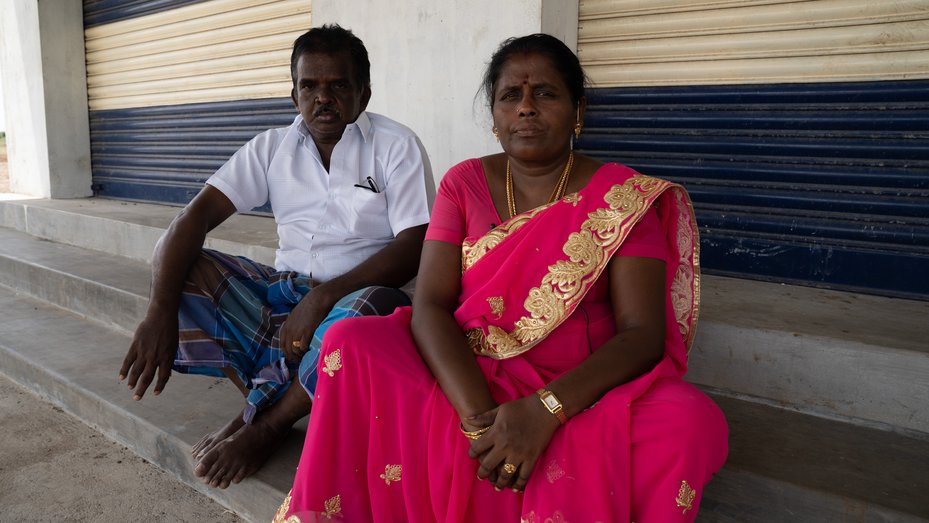
Murugeswari and her husband Muthupandi in Thoothukudi, India. Their 22-year-old son M.Karthik, a student who aspired to become a lawyer, was shot by police on May 22, 2018, at a protest against the Sterlite Copper plant.
Alina Tiphagne/Global Witness
The Thoothukudi massacre is emblematic of the pressing issues of security and reprisals faced by human rights defenders in India. In 2021, India reportedly recorded the highest number of attacks against human rights defenders – representing around 20% of attacks in the Asia-Pacific region. Many defenders, including Indigenous women seeking justice, are jailed and labelled as terrorists due to their human rights work. Laws in India are routinely used to target human rights defenders: for example, the Foreign Contributions (Regulation) Act 2010 has been used to block much-needed funds, freeze bank accounts, and subject NGOs to investigations, creating a chilling effect on civil society. We need urgent action from foreign governments and other members of the international community to hold the Indian government accountable for its treatment of human rights defenders.
Recommendations:
- The government of Tamil Nadu should immediately publish the Justice Aruna Jagadeesan Commission of Enquiry report on the Thoothukudi massacre, together with its Action Taken Report [ATR], and table a discussion on the report’s proposed recommendations at the Tamil Nadu Legislative Assembly. This should include the suspension of all implicated officials, including the District Collector and police officers, and the initiation of criminal proceedings.
- The UN Office of the United Nations High Commissioner for Human Rights (OHCHR) should initiate Special Procedures to assess compliance by the National Human Rights Commission of India (NHRC) with international standards set out by the Paris Principles, given the lack of transparency, and that the complaint on the Thoothukudi massacre was closed within five months of brutal police killings of a total of 16 protestors and excessive violence over 200 others, as well as NHRC's refusal to reopen the matter despite a Madras High Court's ruling to consider the same.
- The government of India – as well as other governments, UN Special Rapporteurs, INGOs, regional NGOs and human rights defenders’ within the global community– must stand with the people of Thoothukudi and ensure justice is achieved for the victims of the Thoothukudi massacre.
Human Rights Defender Alert - India
Global Witness started reporting on the killings of land and environmental defenders in 2012. Since then, 1733 defenders have been killed trying to protect their land and resources: that’s an average of one defender killed approximately every two days over ten years.
As we have stated in each of our reports over the years, our data on killings represents the tip of the iceberg. That’s because conflict, restrictions on a free press and civil society, and lack of independent monitoring of attacks on defenders can lead to underreporting.
We know that beyond killings, many defenders and communities also experience attempts to silence them, with tactics like death threats, surveillance, sexual violence, or criminalisation – and that these kinds of attacks are even less well reported.
These challenges, coupled with the requirement to meet strict Global Witness’ verification criteria for recording killings, mean that our figures are almost certainly an underestimate.You can find more information on our verification criteria and methodology in the ‘Methodology’ section.
Democratic Republic of Congo 70
United States of America 1
Over half of the attacks over a decade: Brazil, Colombia, Philippines
Brazil has been the most murderous country since Global Witness started reporting on defenders. Overall, it represents the country with the highest documented number of killings since 2012, with 342 lethal attacks in total. Around a third of those killed were Indigenous or Afro-descendants, and over 85% of killings happened within the Brazilian Amazon.
The high number of cases in Brazil is partly attributable to a greater awareness and better monitoring by civil society of this issue compared to other parts of the world. Conflict over land and forest rights is the main driver of defender killings in Brazil, with the Amazon rainforest being the frontier of the struggle over Indigenous and environmental rights. Indigenous peoples have an important role to play as guardians of the Amazon forest, in preventing the emissions that come from deforestation and forest degradation, and in helping curb the climate crisis.
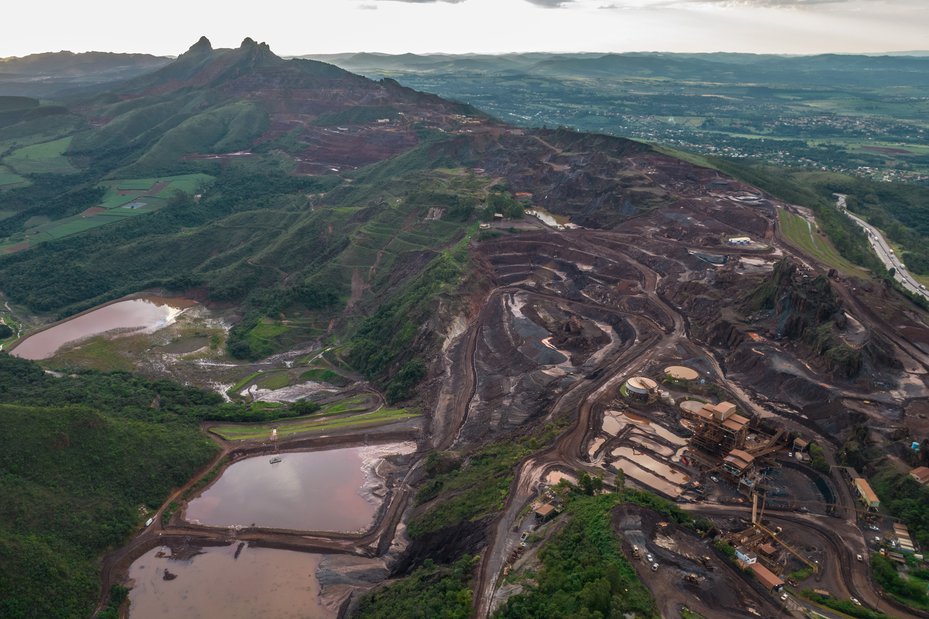
The Mineracao Morro do Ipe mine, Minas Gerais state, Brazil. Heavier-than-normal downpours in January brought flooding that destroyed communities and led to halted iron mining operations across the state. Jonne Roriz/Bloomberg via Getty Images
The Amazon has become a backdrop to increasing violence and impunity. With powerful agricultural interests at the heart of Brazil’s export-focused economy, it is the setting for a battle over land and resources that has intensified following the election of Brazil’s far-right president, Jair Bolsonaro, in 2018. Since Bolsonaro came to power, he has encouraged illegal logging and mining, undone protection for Indigenous land rights, attacked conservation groups, and dismantled and slashed the budgets and resources of forest and Indigenous protection agencies. This has led to criminal gangs invading Indigenous and conservation areas with impunity.
The failure of the state to defend land and environmental defenders even as it gives a green light to illegal resource extraction has led some to suggest that the government in Brazil has been captured by criminal interests.
The high-profile killings of British journalist Dom Philipps and Indigenous expert Bruno Pereira in the bandit territory of the Javari Valley in the Brazilian Amazon are indicative of the assault on Indigenous people and those trying to protect them. Pereira previously worked at the government’s Indigenous agency, Funai. He was removed from his position as the agency’s representative for uncontacted tribes in what was seen as a politically motivated move soon after Bolsonaro came to power. His firing in late 2019 came shortly after his team had helped make one of the biggest illegal mines in the Amazon region inoperable.

An indigenous demonstrator talks to attendants during a protest to ask the government for justice over the assassination of Dom Phillips and Bruno Pereira on June 23, 2022 in Brasilia, Brazil. Andressa Anholete/Getty Images
Closely following Brazil, ten years of gathering data on the killings of land and environmental defenders have placed Colombia as the country with the second highest number of killings. The Colombian government has promised to ensure violence decreases. The reality is proving otherwise.
The Colombian civil society network Programa Somos Defensores, which documents and reports attacks against defenders, has repeatedly condemned the very limited state action, including from the judiciary, to end impunity and a climate of fear. This concern over human rights violations has also been echoed by the UN High Commissioner for Human Rights and the Inter-American Human Rights Commission.
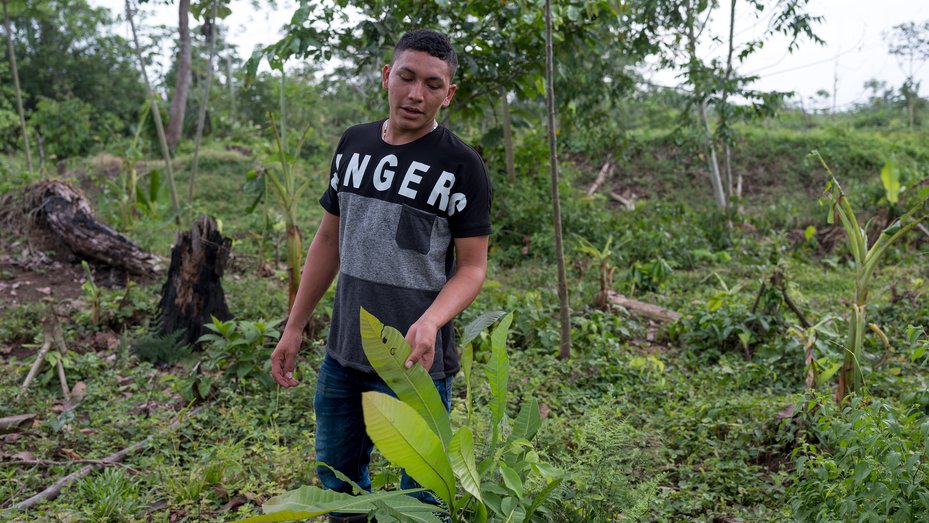
Ramón gives a tour of the land that his family owns in Colombia that has been taken over by palm oil plantations. Ramón's father, Hernan had led local resistance to palm oil. He was shot 15 times.
Thom Pierce/Guardian/Global Witness/UN Environment
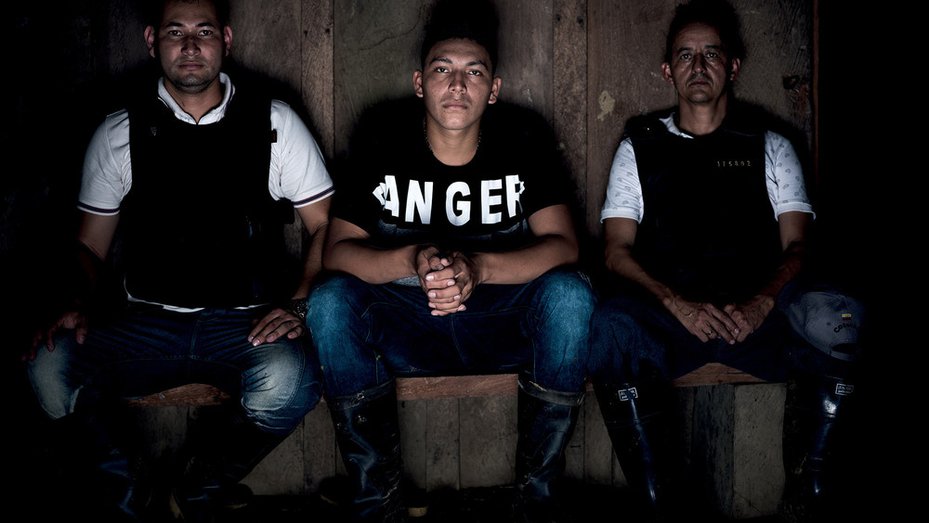
Ramon Bedoya with bodyguards at his family's farm - Pedeguita y Mancilla, Coco, Colombia.
Thom Pierce/Guardian/Global Witness/UN Environment
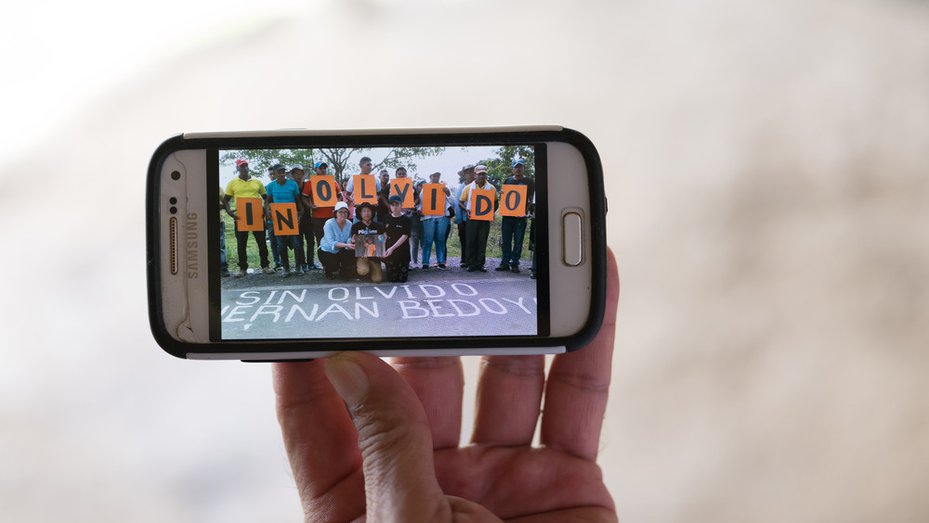
A photograph from the memorial to Hernán Bedoya at the sight where he was murdered in December 2017.
Thom Pierce/Guardian/Global Witness/UN Environment
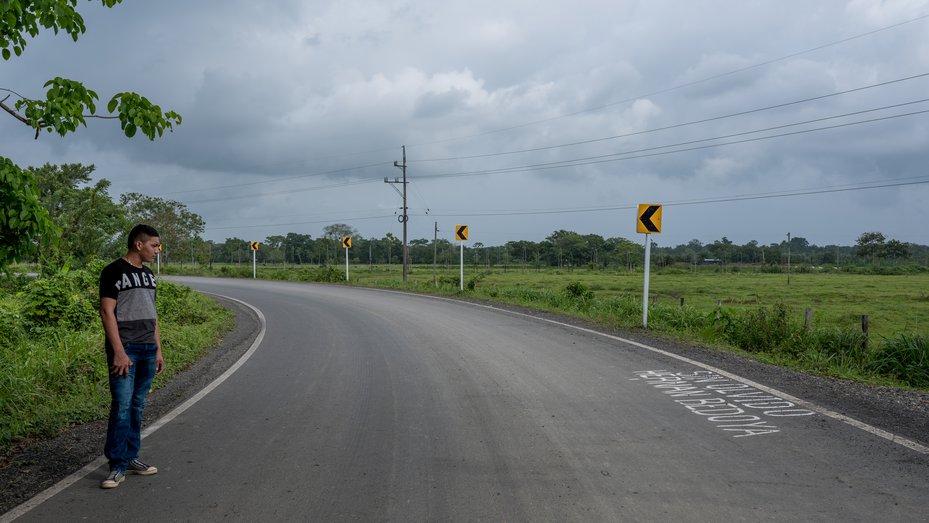
Ramon Bedoya at his father's roadside memorial. This is the exact spot where Hernan was murdered by a gunman on a motorcycle in December 2017.
Thom Pierce/Guardian/Global Witness/UN Environment
The Philippines has consistently ranked as the worst place in Asia for land and environmental defenders, with 270 defenders killed between 2012 and 2021. Over 40% (114) of the defenders murdered were Indigenous peoples campaigning to protect their land and the environment – with nearly 80% of attacks against Indigenous defenders taking place on the island of Mindanao.
Global Witness has been able to link over 80% of killings over the past decade in the Philippines to protests by defenders against company operations. Our analysis indicates that a third of the killings are linked to the mining industry, closely followed by the agribusiness sector. Philippines ranks in the top five countries for mineral resources globally. Nearly 30% of the country’s land is known to hold high mineral deposits, of which over 8% is covered by mining concessions (as of July 2021).
In April 2021, President Duterte overturned a nine-year nationwide moratorium on new mining projects, which had been in place since 2012. Environmental and human rights groups criticised the move, warning that the new order could further endanger defenders as well as negatively impact key biodiversity areas, local water and food supplies, and Indigenous communities. Newly inaugurated President Ferdinand ‘Bongbong’ Romualdez Marcos Jr raised a red flag with his first State of the Nation Address in July this year, emphasising investment incentives including within the energy sector. He made no mention of the country’s dismal record on human rights.

Members of Filipino environmental network Kalikasan join protests in July 2022 demanding that the newly elected President Marcos Jnr take action towards climate justice and protecting defenders. Dennese Victoria/Global Witness
Steaming ahead with development projects without any consideration for human rights raises serious concerns about the future of land and environmental defenders in a country with one of the highest levels of killings of defenders in the world.
There is very little transparency in the Philippines’ mining sector, with mining contracts and data seldom made public. Rules requiring mining companies to gain consent from communities who live in the areas in which they seek to operate are not consistently implemented.
Impunity is rife: it is suspected that state forces are behind the majority of killings in the few cases where the identity of the perpetrators is documented. Key state institutions, including the judiciary and law enforcement agencies, are weak, and the military and police commit human rights violations with little accountability.
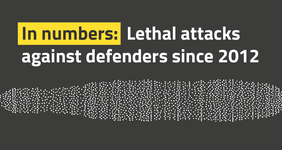
Interactive | September 29, 2022
In numbers: Lethal attacks against defenders since 2012
>Read more
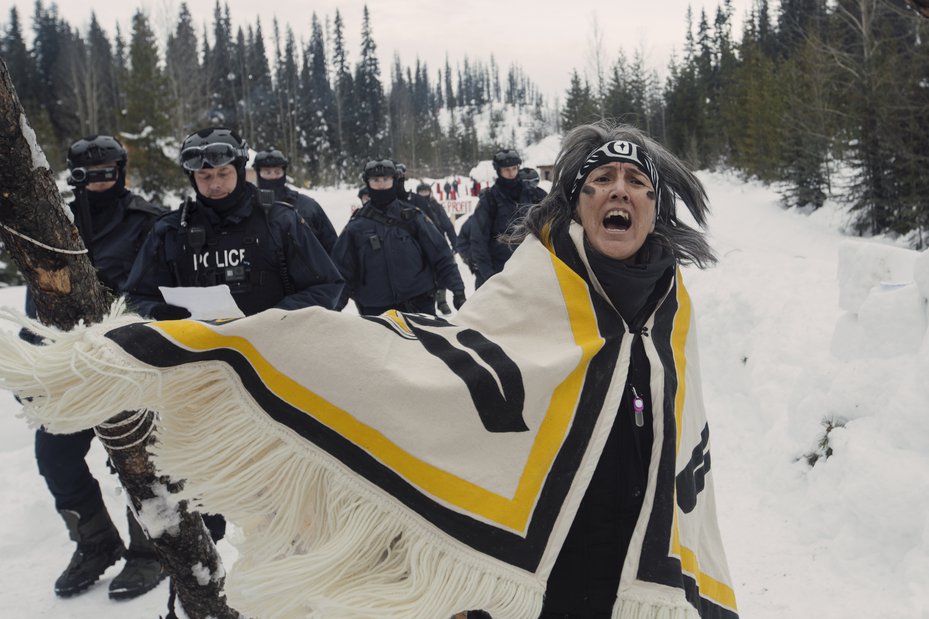
Freda Huson, female chief (Dzeke ze') from the Wet'suwet'en, sings in ceremony as RCMP approach to arrest her during their enforcement of a court-ordered injunction against those blocking work on a gas pipeline in 2020. Amber Bracken/The Narwhal
“You gotta understand our frustration. We’ve been here since time immemorial, before anyone came to these lands. And your law can bend the rules to let somebody come and destroy our land and they get you guys to help them. If it was your house you’d feel the same, if the same vandals keep coming and wrecking your shit and nobody’s doing anything?”
Freda Huson, Dzeke ze' (Chief) Unist'ot'en Clan, Wet'suwet'en Nation in conversation with local police officers
The deep wilderness of British Columbia in Canada is at the centre of a conflict between corporate profits and Indigenous rights over a multi-billion dollar natural gas project — touted as the largest private sector investment in Canadian history. The US$6 billion, 670 kilometre Coastal GasLink (CGL) pipeline has received approval from the provincial authorities, yet Indigenous Wet'suwet'en hereditary chiefs living in the area assert that no pipelines can be built through their traditional territory without their consent.
The Wet’suwet’en have never ceded or surrendered their territory to Canada. They have lived here since time immemorial and govern themselves under Wet’suwet’en law. In fact, Wet’suwet’en hereditary chiefs hold rights and title on ancestral lands recognised by Canadian courts – CGL needs their consent to be able to continue building its natural gas pipeline.
Yet despite the Wet’suwet’en hereditary chiefs stating that they don’t want the CGL pipeline project, the company moved onto the land. Following a Supreme court injunction obtained by CGL in 2019, armed Royal Canadian Mounted Police (RCMP) officers forcefully removed hereditary chiefs and matriarchs, Wet’suwet’en land defenders, and their supporters from their own land. Dozens have been arrested and detained, including several members of the media. Reports from those released cite lack of food, restricted access to legal representation, and poor treatment by RCMP.
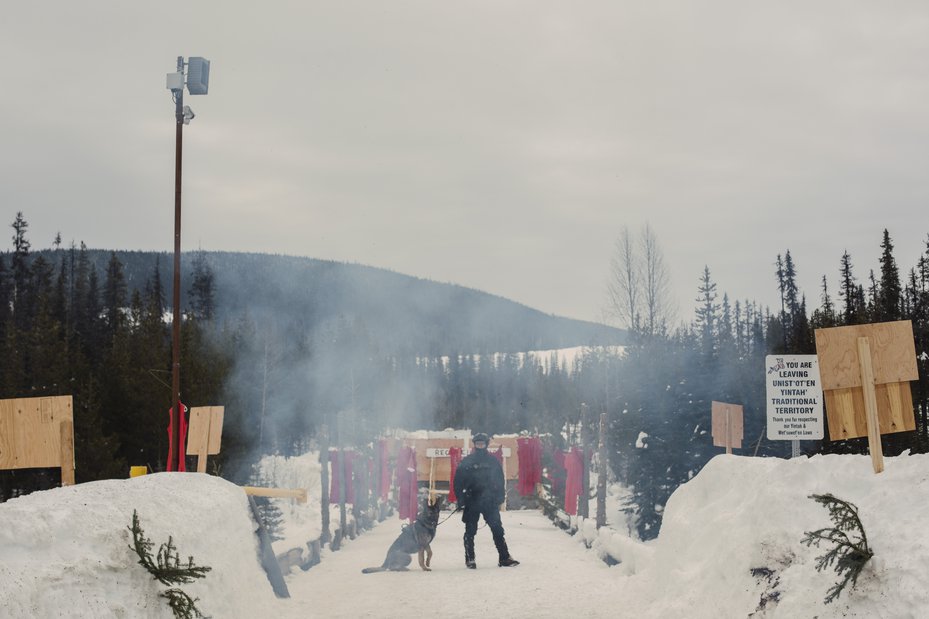
An RCMP officer stands near the Morice River bridge, the only entrance point to the Unist’ot’en healing centre and sole access road to Coastal GasLink work sites. Amber Bracken / The Narwhal
CGL has asked the court to apply release conditions for those detained that may include a requirement for land defenders to prove their Indigenous identity. According to reports from courtroom observers, conditions of release include a prohibition on their return to both their own territory and the ‘exclusion zone’ – an area around the forcible removal area where media presence is prohibited, thus denying public access to information. A recent British Columbia Supreme Court judge ruled the RCMP’s practice of employing vast ‘exclusion zones‘ illegal.
The geographic location of the Wet’suwet’en people is isolated and remote, making it difficult for human rights observers and media to monitor. This situation poses a grave danger to Wet’suwet’en people, territories and culture, and is made worse by the arrests of both legal observers and the media.
The British Columbia provincial government passed the United Nations Rights of Indigenous Peoples (UNDRIP) into law in November 2019. This should ensure the rights of Indigenous peoples to free, prior and informed consent regarding projects that impact their lands and livelihoods. It also states that Indigenous peoples will not be forcefully removed from their lands.
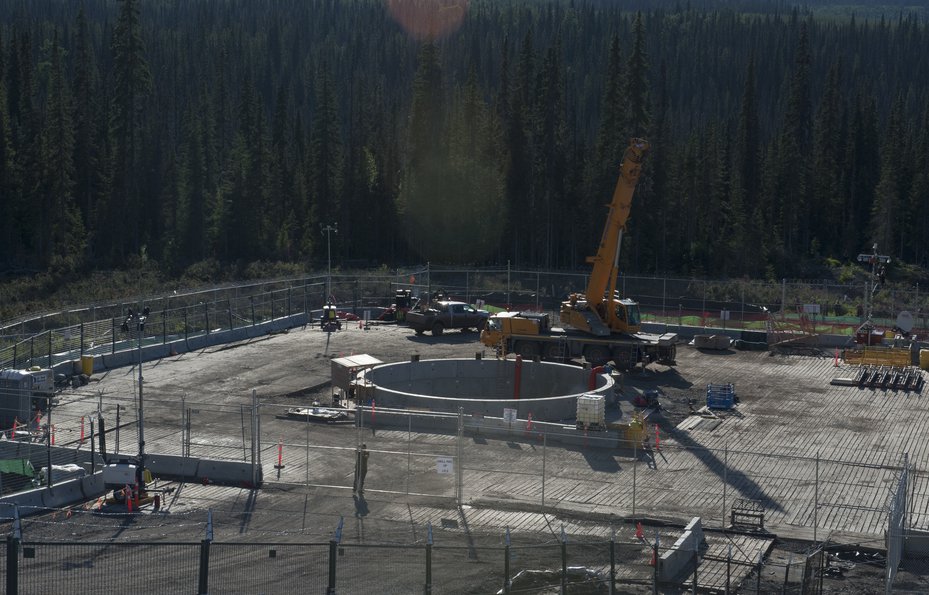
Coastal GasLink preparing to drill under the Wedzin Kwa river. Cedar George-Parker, from the Tsleil-Waututh First Nation, sang to prepare participants for the shock of seeing the scale of the project. Matt Simmons/The Narwhal
In promoting a massive fossil fuel development project, Canada is utterly failing in responding to the severe and immediate climate emergency that the country is facing. Compounding this situation, Canada has engaged in these serious human rights violations against the backdrop of the genocide of Indigenous people, in particular women and girls, in the country. Many Canadian government policies are having devastating effects on Indigenous communities, leading Prime Minister Justin Trudeau to publicly accept that Canada has committed genocide. Remedying this urgently requires the re-empowerment of Indigenous peoples, including the Wet’suwet’en Nation.
Recommendations
The Canadian government should:
- Immediately halt the construction and suspend all permits and approvals for its construction of the Coastal GasLink pipeline in the traditional and unceded lands and territories of the Wet’suwet’en people, until they grant their free, prior and informed consent, following the full and adequate discharge of the duty to consult.
- Immediately cease the forcible eviction of Wet’suwet’en people; guarantee that no force will be used against Wet’suwet’en peoples; withdraw security and police forces from Wet’suwet’en territory; and prohibit the use of lethal weapons by the Royal Canadian Mounted Police against Indigenous peoples.
- Fulfil its obligations to recognise and protect the rights of Indigenous peoples to own, develop, control and use their communal lands, territories and resources and, where they have been deprived of the lands and territories they traditionally owned or otherwise inhabited or these lands have been used without their free and informed consent, to take steps to return those lands and territories. Only when this is for factual reasons not possible, the right to restitution should be substituted by the right to just, fair and prompt compensation. Such compensation should as far as possible take the form of lands and territories.
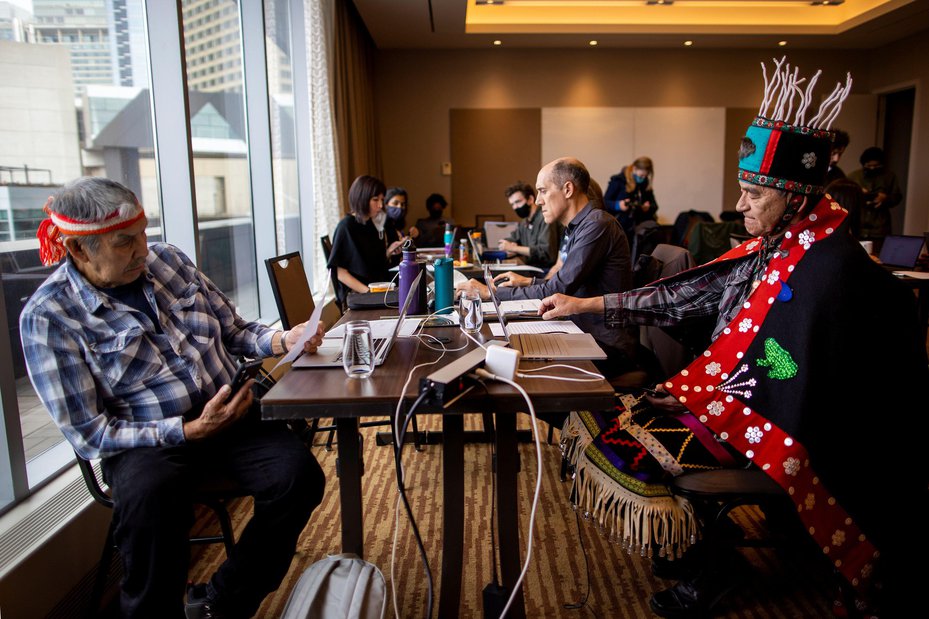
Wet'suwet'en hereditary chief Gisdaywa and chief Namoks listen to the Royal Bank of Canada – a financier of the CoastalGas pipeline - virtual annual general meeting online from a hotel room. Reuters/Alamy Stock Photo
The drivers behind threats and attacks to land and environmental defenders are complex and multiple, but there are intersecting commonalities across the countries where attacks are highest.
Land inequality
Land and territory, and conflicts over their control and use, are central issues in most countries where threats against land and environmental defenders are present. Much of the increasing violence, killings and repression against defenders is linked to such conflicts and the pursuit of economic growth based on the extraction of natural resources from the land. This is exacerbated by extreme inequality in land ownership, which is also is one of the main drivers of social and economic inequality, particularly in Latin America.
Land inequality is central to many global crises, including power and democracy crises and the climate and biodiversity crises. Land inequality is not inevitable, but is the result of political decisions, market forces, or a combination of both. It’s often the legacy of conquest and colonisation, as demonstrated by its prevalence in Latin America. Market forces also drive land inequality by encouraging accumulation, often by an already wealthy elite. Smallholders and family farms, Indigenous people, rural women, and landless rural communities are being squeezed into increasingly smaller parcels of land or forced out entirely as land inequality grows around the world.
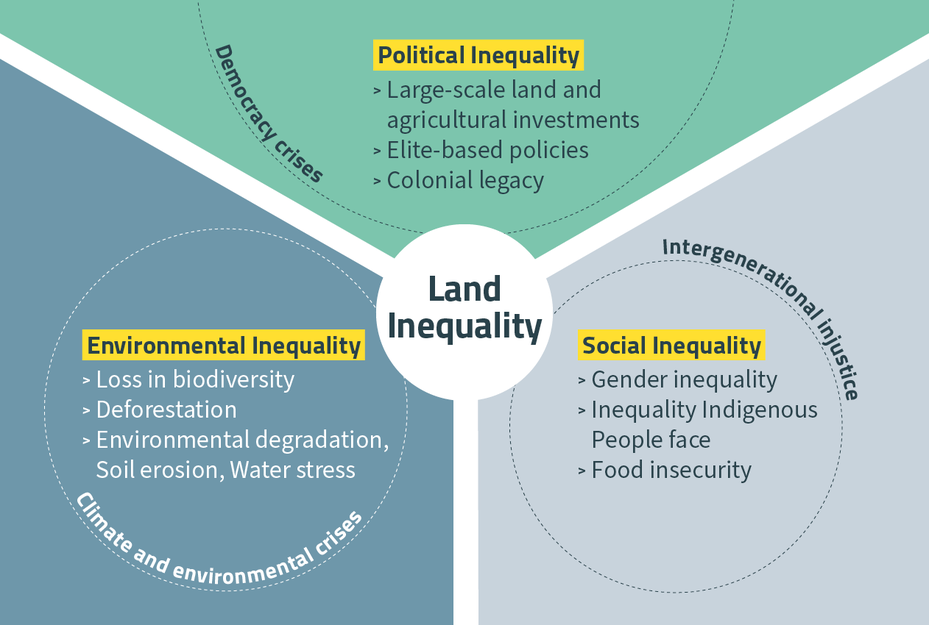
In Brazil, where 342 defenders have been killed over the last decade, the Gini index (the most widely used indicator of inequality) of land ownership distribution is 0.73, placing Brazil among the countries with the greatest land inequality in the world. Research has shown that inequality is greater in the states with highest agricultural commodity production, such as in Mato Grosso, Mato Grosso do Sul, Bahia and in the MATOPIBA region (which comprises the Cerrado biome areas of the states of Maranhão, Tocantins, Piauí and Bahia). Attacks against defenders are also high in these states according to Global Witness data. For example, in Mato Grosso, nine farm workers were tortured and killed in 2017 by hired assassins in an area of illegal deforestation. The same study also points out that 10% of the largest properties occupy 73% of the agricultural area of Brazil. In all Brazilian states, the 10% of the largest properties own more than 50% of the area. In six states and MATOPIBA, the 10% of the largest properties own more than 70% of the area.
44 of the 342 defenders killed in Brazil over the last decade were protesting against agribusiness.
Colombia has the highest concentration of landholdings in Latin America, with the largest 1% of landholdings concentrated over 81% of land, leaving only 19% of land distributed among the remaining 99% of farms.
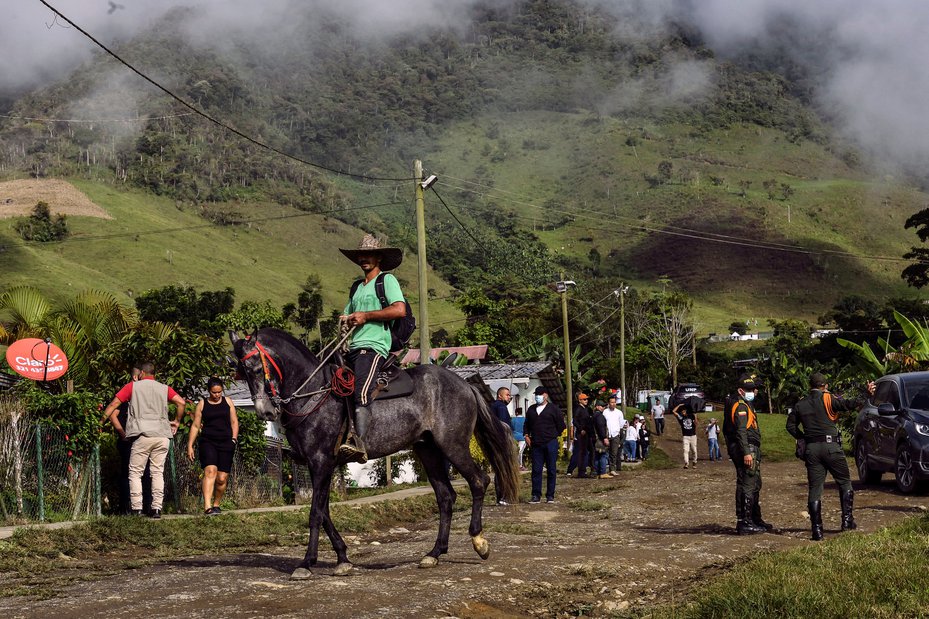
A local is seen at a Territorial Training and Reincorporation Space in Dabeiba on November 23, 2021, a day before the 5th anniversary of the peace agreement between the Colombian government and the FARC guerrilla. Joaquin Sarmiento/AFP via Getty Images
Violent conflict
Colombia also has the longest armed conflict on the continent. It is driven by illicit and criminal economies, including drug trafficking, illegal mining, kidnapping and extortion. This has resulted in the displacement of nearly seven million people and large-scale dispossessions of their land. Social and economic inequality is at the very root of the conflict, especially the extreme concentration of land, in terms of landholdings as well as land use.
Violent conflict over land is well documented and is closely linked to land inequality. Not only do increasing land concentration and land inequality fuel violent conflict, conflict is also a driver of land inequality, which, if not adequately addressed, perpetuates the cycle of violence.
Colombia is one of the countries with the highest number of recorded killings over ten years of Global Witness data. Not only are conflicts associated with land and natural resources numerous and frequent, but they are also often protracted and twice as likely to recur in the first five years as other types of conflict. These conflicts are further fuelled by crises such as climate change, democratic crisis and mass migration, which are further hotbeds for political, economic, social and environmental instability.
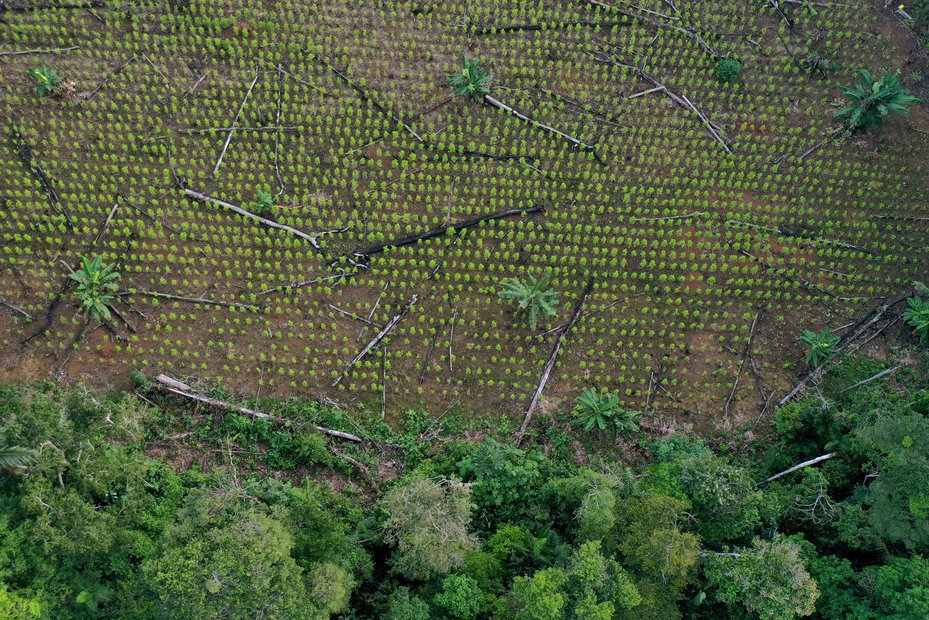
Aerial view of a coca field amid remains of deforested trees in Guaviare department, Colombia. The Colombian Amazon is experiencing environmental degradation due to illicit crops, intensive farming and illegal mines. Raul Arboleda/AFP via Getty Images
Corruption
Driven by the rising demand for food, fuel and commodities, the last decade has seen an upsurge in land grabs for industries like mining, logging, agribusiness and infrastructure projects, with local communities rarely consulted or compensated. The actors colluding to grab land tend to be corporations, foreign investment funds, national and local state officials, and the governments of wealthy yet resource-poor nations looking to cheaply acquire land, harming local populations in the process.
Land and environmental defenders trying to gain access to remedy are heavily impacted by corruption ranging from corrupt judges hearing defender complaints to police and local authorities being bribed to threaten, intimidate or even arrest community members who are protesting or submitting complaints.
Shrinking civic space
Threats to global democracies are on the rise and countries in every region of the world have been captured by authoritarian rulers in recent years. In 2021, Nicaragua’s incumbent president won a new term in a tightly orchestrated election, after his security forces arrested opposition candidates and deregistered civil society organisations. Elected leaders from Brazil to India have taken or threatened a variety of antidemocratic actions, leading to a weakening of democratic values on the international stage, including the repression of civic space. Whenever states and corporations stifle critical voices and crackdown on political dissent – whether in the streets, on social media, or in the courtroom – they shrink the civic space necessary for a democratic society based on human rights to thrive.
The safety and security of human rights defenders and increased threats to civic freedoms has become an increasing concern globally. It is also one of the most urgent issues for the human rights agenda, as defenders find themselves at great personal risk, including the risk of death and grave bodily harm. Civil society also finds itself with fewer avenues to express concerns regarding human rights issues, fearing criminal prosecution.
The majority of killings over the last decade have all taken place in countries with severely restricted civic space.
Killings in closed civic spaces are likely to be underreported
Culture of corporate impunity
In countries across the world, corporations are operating with impunity, facilitated in part by corruption. Guidelines for business to prevent harms remain voluntary for the most part, meaning violations of environmental and human rights continue to abound and the price for fighting back can be fatal.
Few perpetrators of killings of defenders are ever brought to justice due to the failures of governments to properly investigate or prosecute anyone for these crimes. Many authorities either turn a blind eye or actively impede investigations into these killings, which can be due to the collusion between corporate and state interests – one of the root causes of the violence against defenders. Such impunity for threats and attacks against defenders acts as a green light to potential perpetrators, who see that they are unlikely to face consequences for attacks on activists.
In many cases, access to information, often held by companies, makes it difficult to find those responsible. Companies’ global supply and value chains are unnecessarily opaque and complex, making it hard for communities to know who is accountable for harms.
When looking at the dataset on attacks in totality, it’s clear that many companies engage in an extractive economic model that overwhelmingly prioritises profit over human and environmental harm. This unaccountable corporate power, supported by government policies, is a significant underlying force that has not only driven the climate and biodiversity crisis to the brink, but which has continued to perpetuate the killing of defenders. Simply put, the fetishisation of endless economic growth and corporate impunity must end to preserve life.
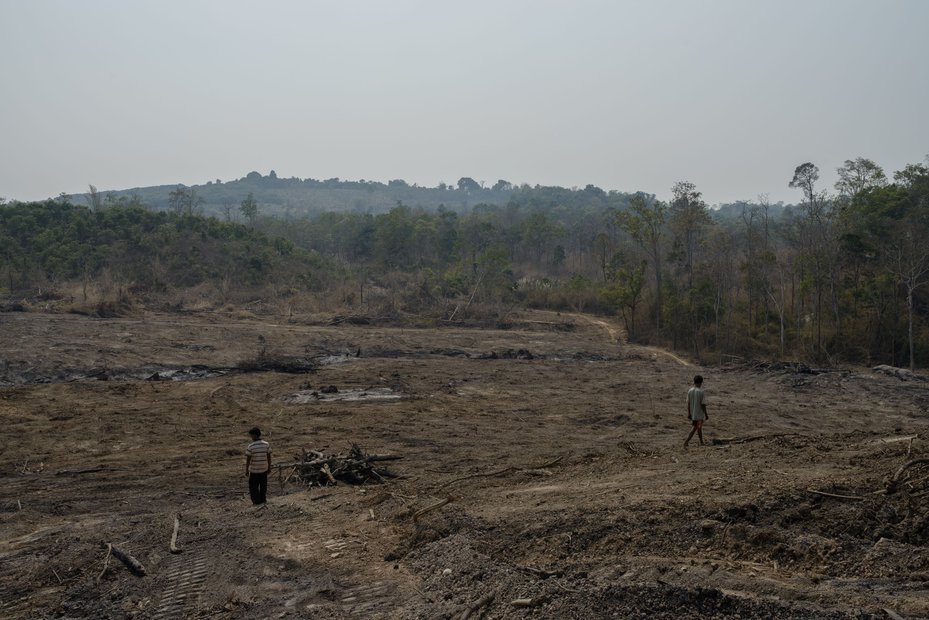
Local residents walk through what was once forest, cleared to make way for a rubber plantation in Ratanakiri Province, Cambodia, March 2013. Chris Kelly/Global Witness
A 1396-sq-km swath of the jungle-clad limestone mountains northwest of the city of Colima is protected by UNESCO as critical habitat. Ranging in elevation from 400m to 2,960m, with eight varieties of forest ecosystem – including tropical, cloud, oak and alpine – this land counts nearly 2,900 varieties of plants, 336 bird species (a third of Mexico’s total), 85 amphibians and reptiles and 110 mammals, including puma, jaguar and ocelot.
Lonely Planet
So begins popular travel guide Lonely Planet’s introduction to the Sierra de Manatlán UNESCO Biosphere Reserve in Mexico, which is rich in wildlife and home to Indigenous groups. Yet there is a dark side to the popular tourist area.
In April 2021, José Santos Isaac Chávez was brutally murdered. He was an Indigenous leader, lawyer and candidate to the Ejidal Commissariat of Ayotitlán (a local elected body created to manage the Indigenous territories and coordinate actions with communities). He was the only candidate who vocally opposed the Peña Colorada mine and its operations. He was found dead in his car, which had been driven off a cliff. His body showed evidence of torture.
José’s murder is far from the first connected to the mine: local reporters and activists allege disappearances and murders related to opposition to Peña Colorada for which no one has been brought to justice. Operations began in the 1970s representing decades of serious violence and human rights abuses connected to the mine.
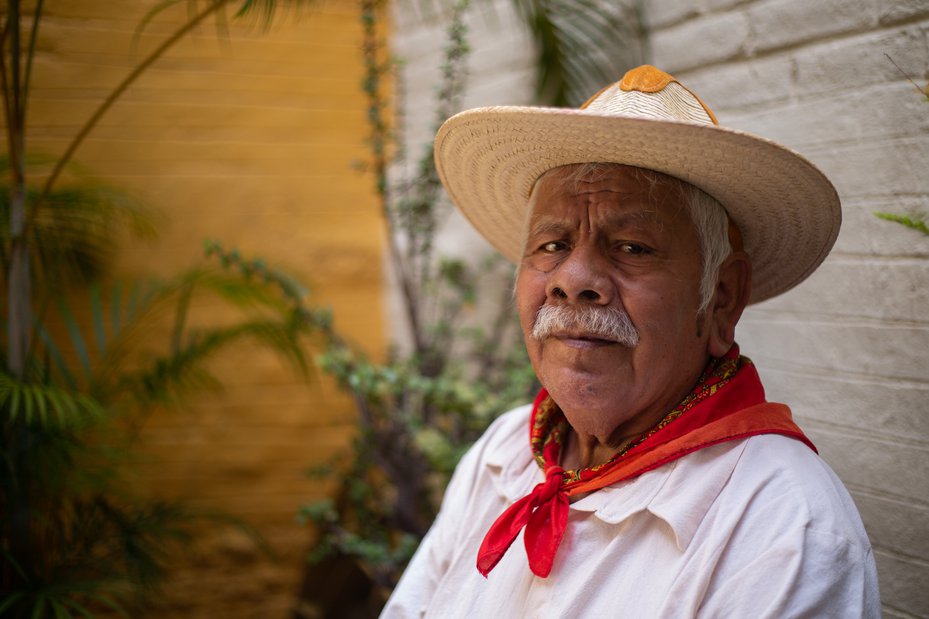
Felipe Roblada in Mexico City, on 29 August 2022. Felipe Roblada, President of the council of elders of the town of Ayotitlan, is involved in activism around the Peña Colorada mine in Jalisco, Mexico. Quetzalli Nicte Ha/Global Witness
A joint venture between the multinational steel corporations, ArcelorMittal and Ternium – both headquartered in Luxembourg – the Peña Colorada open-pit mine has been a scourge on the environment, including local Indigenous territories, since operations began. The mine has destroyed the Cerro de Los Juanes mountain, turning the surrounding area into a wasteland. Mining operations have driven deforestation, loss of wildlife, climatic changes and toxic contamination. The true scale of harms has been impossible to quantify, however, as the mining company maintains tight control over the Sierra de Manantlán area. Independent investigators are not allowed to enter the mine area, much less to verify operating conditions and compliance with environmental protection regulations. There is no evidence that the joint venture operators, ArcelorMittal and Ternium, have procured the death of any land defender at any time.
In addition, the Jalisco Nueva Generación Cartel has established an interest in illegal mining. The illicit group imposes its conditions and violence against the Indigenous community with complete impunity and without an adequate response from the Mexican State.
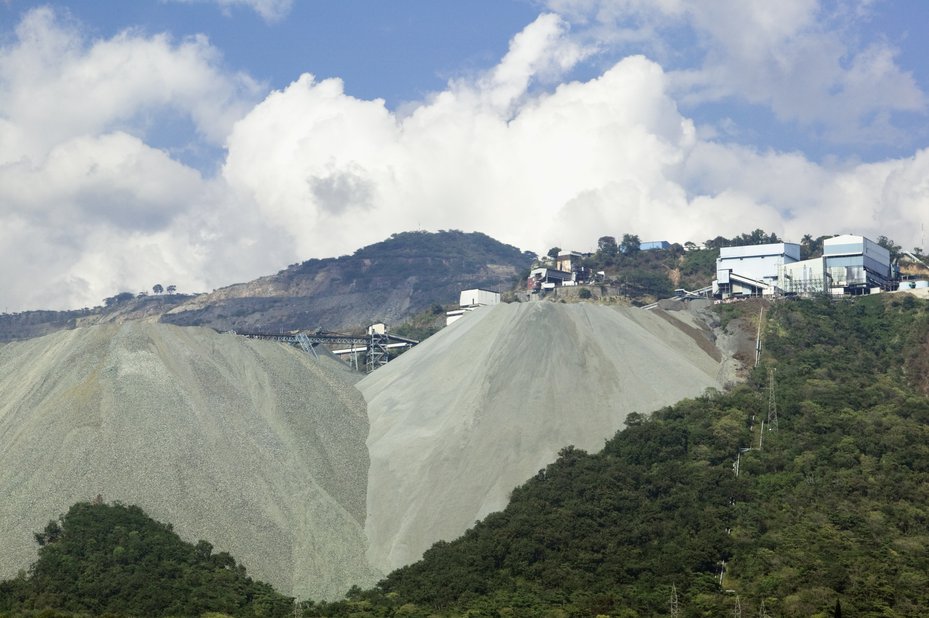
Peña Colorada iron ore mine, Mexico. The mine has destroyed the Cerro de Los Juanes mountain, turning the surrounding area into a wasteland, and driving deforestation, loss of wildlife and toxic contamination. Walter Bibikow/Getty Images
The Indigenous groups in the area have long defended their territory and natural resources. Local activists have taken various actions to contain the expansion of mining operations, some with fatal consequences. Both the Mexican government and the companies that own the mine, ArcelorMittal and Ternium, must take urgent action to prevent further fatalities and violence, and ensure that justice is served for the murders and disappearances of defenders who have opposed the mine.
Recommendations
The government of Mexico should:
- Fulfil its obligations to investigate, provide justice and redress human rights violations against defenders of land and the environment in Mexico.
- Establish a roadmap for the implementation of the Escazú Agreement that includes coordination between state powers, the generation of policies and adequate funding in order to guarantee environmental justice mechanisms, transparency, access to information and a safe environment for the exercise of the environmental defence in Mexico.
- Recognise the situation of the Nahual community in the Sierra de Manantlán as a systemic attack against this Indigenous population and address the structural causes of the repetition of these acts of violence.
- Design, implement and oversee mechanisms that guarantee Indigenous peoples' right to informed consent under international standards and incorporate the principle of self-determination and autonomy of Indigenous persons and communities in Mexico.
Tsikini AC
What have we learnt since Global Witness started reporting on the killings of land and environmental defenders ten years ago? At the international level there has been some progress made by governments and corporations, at least superficially. Businesses are now more aware of the threats that defenders face and, according to the Business and Human Rights Resource Centre, at least 30 businesses have existing policies on human rights defenders and civic freedoms.
However, it's important to note that these are voluntary commitments and they are not implemented consistently. Some governments, predominantly in Europe, either have or are in the process of introducing mandatory human rights and environmental due diligence for companies. And the Escazú Agreement brought into force in 2021 is the first legally binding instrument in the world to include provisions on environmental human rights defenders.
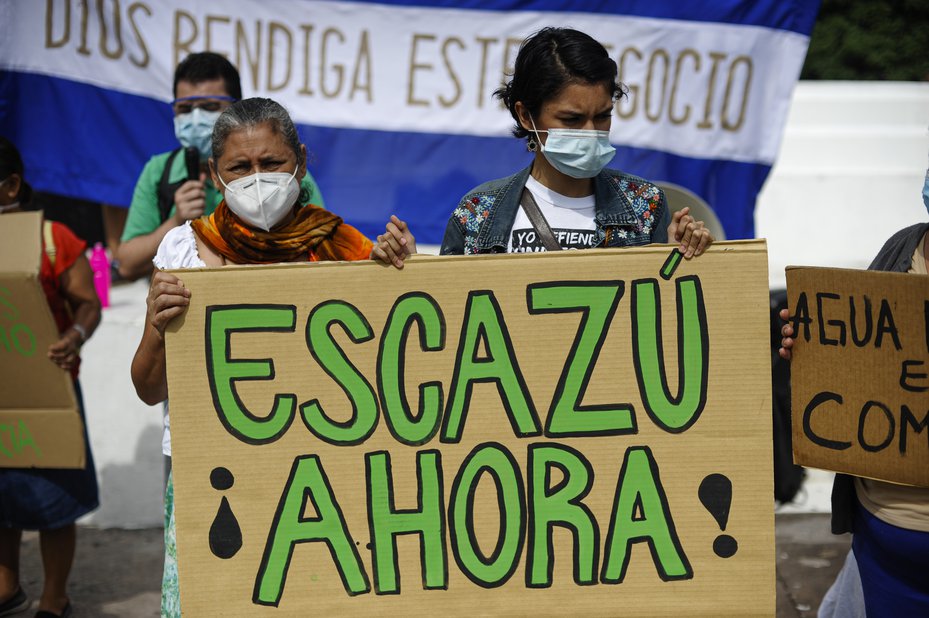
Women hold up a sign during a protest for the signing of the Escazú deal on September 24, 2020 in El Salvador. So far 24 countries from the Latin-American and Caribbean region have signed the environmental treaty. Camilo Freedman/APHOTOGRAFIA/Getty Images
Each and every death of a defender is a sign that our economic system is broken. Fuelled by the pursuit of profit and power, there is a war over nature and the frontlines are the Earth’s remaining biodiverse regions. The integrity of these systems is under attack from organised crime and corrupt governments who want to exploit timber, water and minerals for short-term, often illegal profits.
Most of these crimes happen in places that are far away from power and are inflicted on those with, in many ways, the least amount of power. In many regions, Indigenous communities, Afro-descendants and other traditional forest dwellers, supported by civil society organisations, journalists, lawyers and academics, are leading the push back against irresponsible government and corporate actions. As a consequence, they are disproportionately affected, making up over a third of all the defenders killed. Their deaths represent not just a loss of life, but of traditional cultures, languages and knowledge. These killings happen in places where the law doesn’t function or where it’s controlled by local business or political interests, resulting in almost total impunity. In fact, most killings are not even credibly investigated.
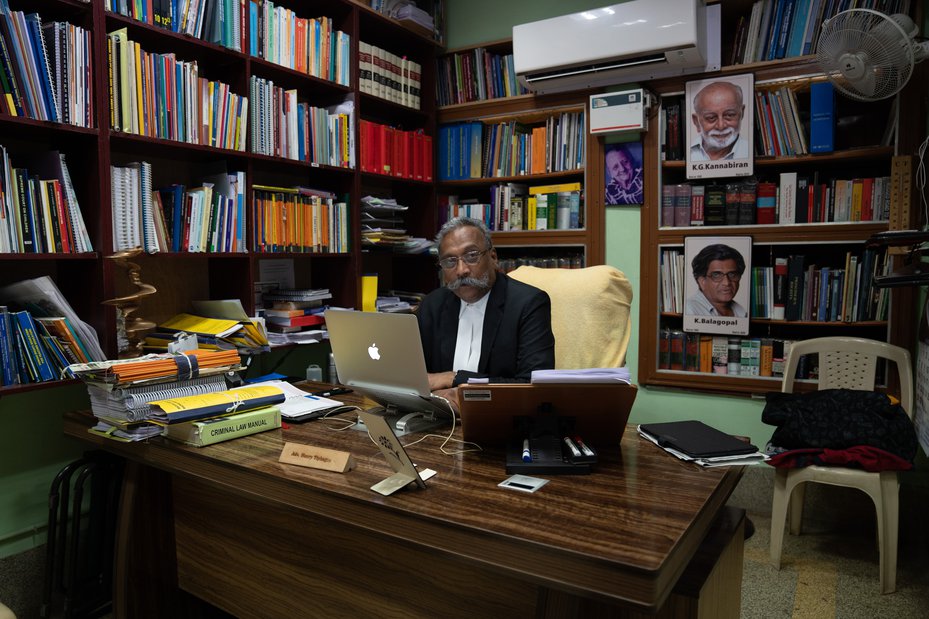
Human Rights Lawyer and National Secretary of Human Rights Defenders Alert – India, Henri Tiphagne at his office in Madurai, India. Tiphagne has represented anti-Sterlite protesters in court. Alina Tiphagne/Global Witness
Species are being lost at about a thousand times the natural rate of extinction. We stand in the midst of a climate emergency. These crises of biodiversity loss and climate are finally getting some attention and their connection to another loss – that of Indigenous cultures – is increasingly being recognised. From animals to insects and plants, climate change and biodiversity loss cannot be effectively addressed without tackling the rapid disappearance of Indigenous cultures. The two are inextricably linked.
As in any war, the dominant side will always want the number of victims and their names to be unknown, for them not to be personalised. In this way, the powerful can create their own narrative around the victims. Yet through our reporting on where they have succeeded in halting damaging projects, or won rights to their land, we can see power lies in resistance and collective protest. So whilst this report aims to raise the alarm in urgently calling for greater protections for defenders, it also aims to inspire rather than deter so that there is even more attention on their struggle.
It is crucial that the work of land and environmental defenders is continued and amplified. This is why Global Witness will continue to report on defenders – to show their value to the world and how they contributed to their communities and their families.
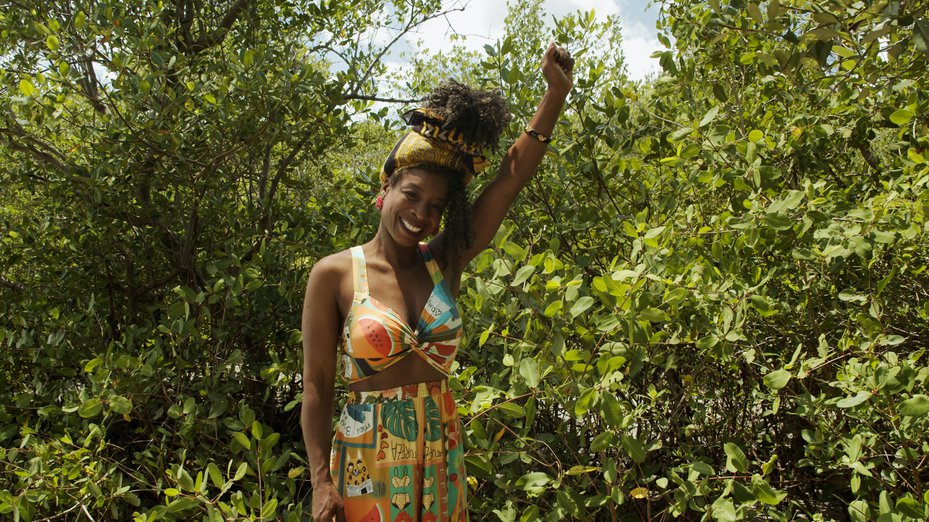
For more than two decades, Brazilian defender Eliete Paraguassu has been involved in the struggle for the rights of her community, against the occupation of their territory by petroleum companies. Safira Moreira/Global Witness
I am a black woman, shellfish gatherer and a Quilombola.
I am a woman from the waters and proud to be a Quilombola shellfish gatherer. I was born into the Porto dos Cavalos community on the Ilha da Maré, an island just off the coast of Salvador, the capital city of Bahia State, Brazil, in the heart of Todos os Santos’ Bay. Porto dos Cavalos is one of six Quilombola territories (settlements of Afro-descendents who were slaves) that have been recognised by the state in the Ilha da Maré. The island, the second largest in the Bay, is also known as “the blackest neighbourhood” in Salvador.
For more than two decades, I have been involved in the struggle for the rights of the Quilombola community, against the exploitation of our territory by national and international companies based in the Todos os Santos’ Bay.
In addition to the exploitation of our territory, we also suffer from the daily chemical contamination caused by the companies, as well as by what the companies called “accidents” – but which I consider environmental crimes – which take place on a recurring basis causing a variety of harms to the community. This heavy pollution in our waters, contamination of our air and poisoning of my people has gone on for far too long – we now call both our land and our bodies the “sacrificial zone”.
The turning point in my life came when I discovered that my daughter had been directly affected. In 2005, a study revealed that children living on Ilha da Maré, including my daughter, had high levels of heavy metals in their hair and blood samples. The food consumed by our children also presented a high level of contamination. We women from the waters are suffering, because our children are developing serious illnesses, including epilepsy and cancer, due to the contamination.
So we continue to be on the frontline of this battle. We are faced by many problems every day, but we have no other recourse but to resist. This resistance comes with a price – a high one. For protesting against these environmental crimes and harms to our health, we have been subjected to death threats, legal harassment and smear campaigns. The threats to my life have gotten so bad recently that I had to adopt a security scheme that obliges me to constantly leave the Ilha da Maré and that does not allow me to do what I most enjoy doing in life: gathering shellfish.
My resistance continues and I will not let them stop me. The government continually fails us. The current crisis is a reflection of the total impunity that we, the people of Ilha de Maré, have suffered for decades.
We will continue to fight the systematic environmental racism enacted toward Quilombos and the Indigenous communities of Brazil. Without a fight, there’s no environmental justice, there’s no victory. We will continue fighting and we will continue defending our territory and our lives and the lives of our children and the lives of future generations. We are fighting not only for our community, but for yours too – for food sovereignty, for access to water free from contamination and for a healthy environment. We need you to join us in this fight.
Eliete Paraguassú
Recommendations
The government of Brazil should:
- Immediately work to stop the ongoing land and human rights abuses and litigation against the communities, and provide credible remedy for those harms already perpetrated.
- In accordance with ILO 169, provide mechanisms for the prior consultation and participation of quilombos with respect to all policies, agreements, or development projects that may affect their ways of life and traditional territories.
- Tackle the public health crisis and social inequality through adequate investment in basic sanitation, including the supply of drinking water, sanitary sewage, as well as the proper handling and disposal of waste.
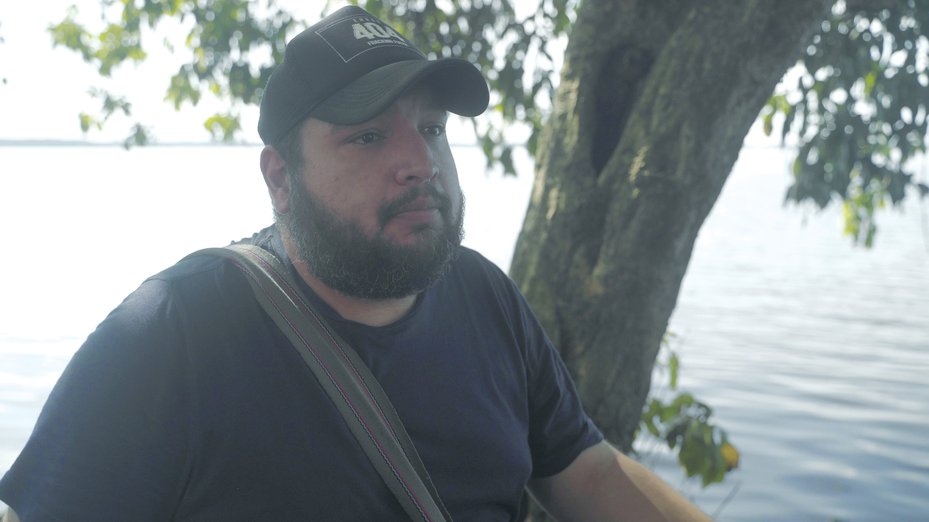
Óscar Sampayo, anti-fracking activist and community leader, Barrancabermeja, Colombia, 21 July 2022. Sampayo has been actively opposing oil extraction in Barrancabermeja, Colombia, for years. Negrita Films/Global Witness
Since November 2020, the threats, intimidation and pressure that I have experienced from groups such as the Aguilas Negras (the ‘Black Eagles’: far-right drug trafficking, counter-revolutionary, paramilitary organisations) and other groups, due to my work in defence of human rights and nature in the Magdalena Medio region of Colombia, is similar to that experienced by dozens of leaders living in the region. A female leader has had to flee to France in 2022. I have lived through the assassinations of three friends and environmental leaders: two were assassinated in February and one at the end of July.
I have been actively opposing oil extraction in the Magdalena Medio region for years. The interests of the big oil companies have ended up prevailing over the lives of local communities, who suffer serious environmental and social impacts, as well as a wide range of human rights violations.
The local community here in Barrancabermeja has witnessed how our land, that used to be so full of life and nature, has been sacrificed time and time again. Since 2013, we have been documenting how our government has continued to choose money over the protection of the local area and the people living in it.

Óscar Sampayo photographs a dead manatee, Barrancabermeja, 21 July 2022. The wetlands around the Colombian city have for a long time been battered by pollution, including from the region’s oil industry. Negrita Films/Global Witness
There are so many things to worry about. We are worried about the environment around us, worried about water pollution, worried about our health, and we are worried about our safety most of all.
As well as fighting oil extraction, we are also fighting serious contamination from a local landfill site. My colleague Yesid Blanco, a paediatrician, identified a series of illnesses from mercury poisoning that were directly linked to the landfill contaminating the water supply of the village of Patio Bonito in Barrancabermeja. It is difficult to find a child in Patio Bonito who was born after 2015 and does not have respiratory problems and skin conditions. They are the generation who have been nicknamed “the children of garbage”.
Yesid is now in exile after sharing his findings – he fled Colombia in 2018. Others have continued to monitor the impacts and document the death of thousands of fish, animals with deformities and the birth of dogs without brains. Every day, the equivalent of 55 Olympic pools of leachates (toxic chemicals) have been dumped on the landfill. And we are being persecuted, stigmatised and threatened for continuing to push for accountability. Both the authorities and private stakeholders are behind these threats.
The fossil fuel companies operating here and companies that have managed the landfill site over the years are not conducting rigorous due diligence. We are worried that the supply chain is permeated by illegal stakeholders with alleged links to armed groups, including paramilitaries, guerrillas and drug traffickers. We cannot defend ourselves against these people, so we need help to protect the local area and the people that live here.
Óscar Sampayo
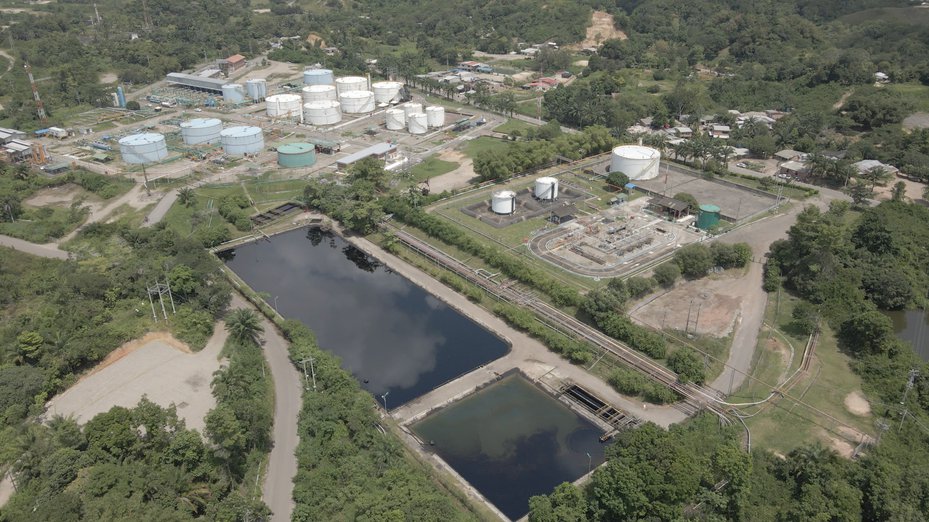
Aerial view of a water treatment plant, Barrancabermeja, Colombia, which deals with waste from local oil refineries, 21 July 2022. Negrita Films/Global Witness
Recommendations
The government of Colombia should:
- Reestablish all spaces for dialogue with civil society that are related to the situation of human rights defenders.
- Adopt and implement the existing series of resolutions and recommendations from national organizations and international organizations that provide a roadmap to guarantee a safe and favorable environment for defenders. These include recent reports by the UN Special Rapporteur on human rights defenders and the Inter-American Commission on Human Rights, and The Protocol of Hope - a civil society initiative - designed to minimize and address threats against human rights defenders. These recommendations should be the starting point for the construction of a comprehensive protection policy for human rights defenders.
- Implement the provisions of the Peace Agreement that are specifically related to the right to defend human rights.
Carbon heist – false ‘solutions’ to climate change and threats to Land and Environmental Defenders
To effectively tackle the climate crisis, we have to leave fossil fuels in the ground. Yet in recent years, companies have been increasingly turning to the voluntary carbon market (VCM) – a system for creating and trading carbon credits – as a substitute for urgently needed emissions reductions. Not only is this ineffective, but it also presents a real and additional threat to land and environmental defenders.
The VCM is dominated by credits generated by forestry and renewable energy projects. Recent growth in the VCM and forecasts for its expansion over this decade have serious implications for land rights and the natural world. Its advocates (of whom there are many, including in the finance and fossil fuel sectors) are exploiting carbon sinks in the Global South. Much of the land targeted for carbon projects overlaps with areas traditionally held by Indigenous, local, and Afro-descendant peoples. This means it is likely that an avalanche of land-grabs will ensue in what some have called a ‘Carbon Heist’.
Numerous projects linked to the carbon market have given rise to alleged serious human rights abuses:
- The Aguan Biogas project has been linked to assassinations and other serious human rights abuses in Honduras
- Green Resources’ industrial tree plantations in Uganda has led to the eviction of thousands of people, and many of those evicted report being subjected to physical violence at the hands of the police
- Francisco Martínez, a prominent member of an Indigenous organisation in Honduras, was stabbed to death in January 2015 – one of three members of the community to be killed that year for resisting the construction of hydropower projects linked to carbon offsetting on Indigenous territory. No one has yet been held by the law to be responsible for the deaths in Honduras.
Decision-makers in climate negotiations have also failed to put human rights at the forefront of climate solutions. At COP21 in Paris, representatives from Indigenous nations around the world took to the streets to draw attention to key clauses that had been removed – those that made binding commitments to the protection of human rights and the rights of Indigenous peoples in climate change solutions. Since then, opposition from Indigenous groups to carbon-offsetting projects that are increasingly framed as ‘nature-based solutions’ has grown. At COP26 in 2021, an Indigenous activist, Thomas Joseph from the Hoopa tribe, California, referred to the push for market-based solutions and commodification of nature as a death sentence.
Indigenous campaigners advocate a holistic approach to climate change, one which centres on climate justice as well as emphasising the importance of leaving fossil fuels in the ground. The latest IPCC report also urges the need to avoid actions that further deepen existing social inequities and lead to adverse outcomes. For this vision to be achieved, it is crucial that Indigenous land and resource rights are respected, and environmental defenders protected.
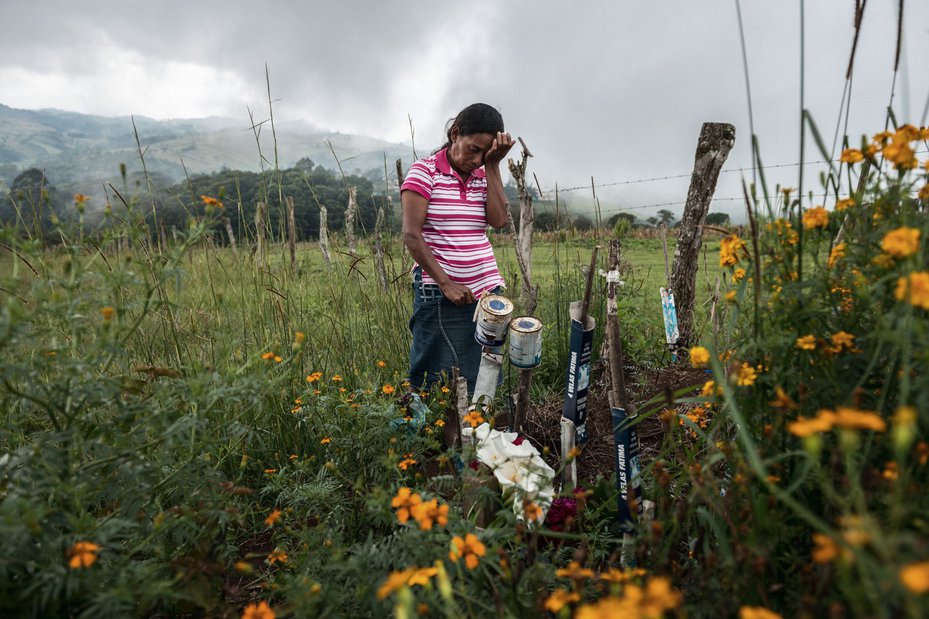
Julia Francisco Martinez, widow of Indigenous activist and human rights defender Francisco Martinez Marquez. Francisco was found murdered in January 2015 after months of death threats. Giles Clarke/Global Witness
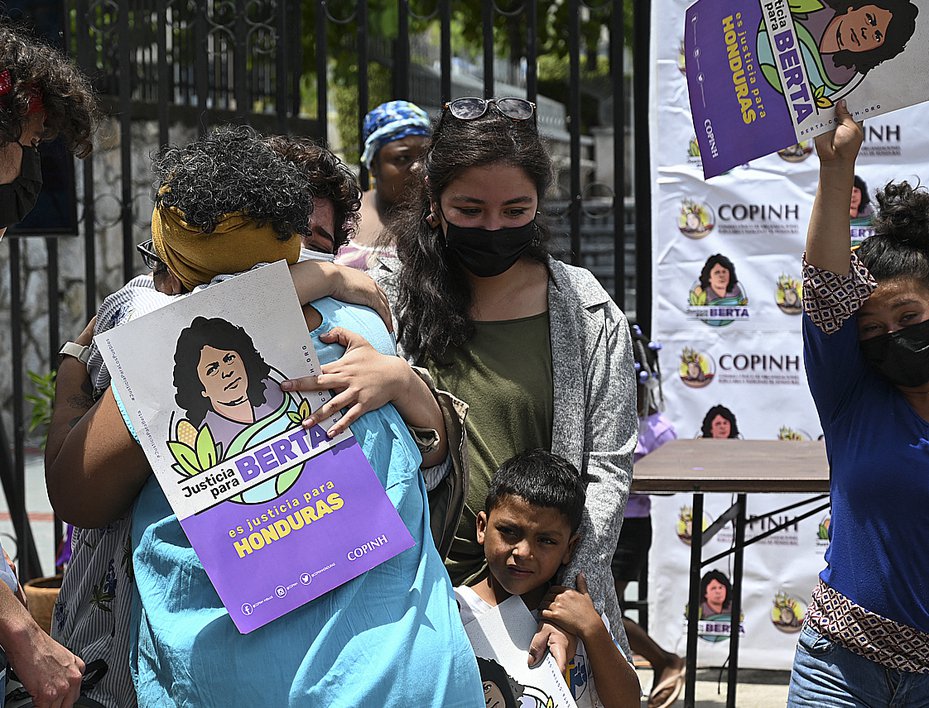
Members of Honduran organisation COPINH embrace to celebrate after David Castillo was found guilty in the murder of Honduran environmentalist and Indigenous leader Berta Cáceres, in Tegucigalpa on July 5, 2021. Orlando Sierra/AFP via Getty Images
Honduras
Five years after the murder of environment and Indigenous defender, Berta Cáceres, in July 2021 a Honduran court found Robert David Castillo guilty of co-conspiring in her murder when he was the head of the hydroelectric dam company Desarrollos Energéticos. Cáceres was shot dead by hired hitmen in 2016, after years of threats linked to her opposition of the Agua Zarca dam on the Gualcarque River, home to the ancestral lands of her Lenca people. Castillo was subsequently sentenced for 22 years for his role in ordering and planning the murder on 20 June 2022.
Cáceres was best known for defending Indigenous Lenca territory and natural resources, but she was also a respected political analyst, women’s rights defender and anti-capitalist campaigner. Her daughter, Laura Zúñiga Cáceres, welcomed the sentencing as another step in the fight for justice. “This is an important advance but the masterminds of the crime are still enjoying impunity thanks to their political and economic power. As victims of this crime, we, her family, members of COPINH (Civic Council of Popular and Indigenous Organisations of Honduras) and the Lenca people will continue demanding justice from the Honduran state.”
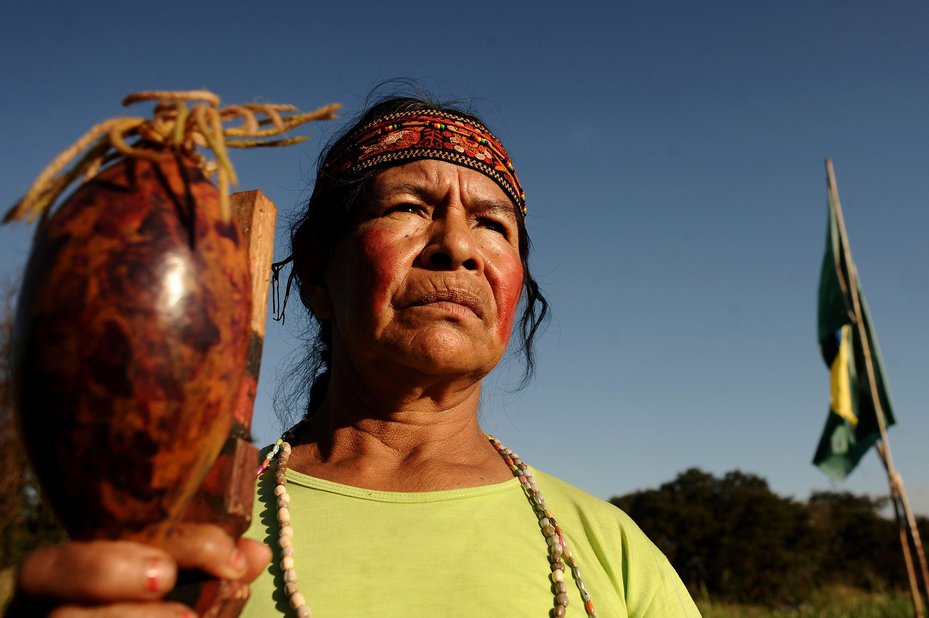
Guarani Kaiowa Indian leader Damiana stands on a roadside as members of her tribe hold up banners for drivers to read about their claims to their ancestral land now controlled by large-scale farmers, Mato Grosso do Sul. Reuters/Alamy Stock Photo
Brazil
In April 2021, in a landmark decision that could bolster Indigenous land rights in Brazil, the country’s Supreme Court unanimously agreed to review the process around a past case that cancelled the mapping of an Indigenous territory claimed by the Guarani Kaiowá people. The Guyraroká territory at the centre of the dispute sprawls across some 11,000 hectares (27,181 acres) of Mato Grosso do Sul, in Brazil’s agricultural heartland. A large part of the disputed area is controlled by José Teixeira, a powerful politician and rancher.
The Guarani Kaiowá people say their land — part of Brazil’s vast tropical savanna biome known as the Cerrado — was stolen decades ago and turned into sugarcane plantations, forcing them off their ancestral lands.
The decision is especially important within the current political context, in which rhetoric from President Bolsonaro’s rhetoric has emboldened attacks on Indigenous land rights. The reopening of the case marks a turning point and also sets an important precedent for other disputes over Indigenous lands in Brazil.
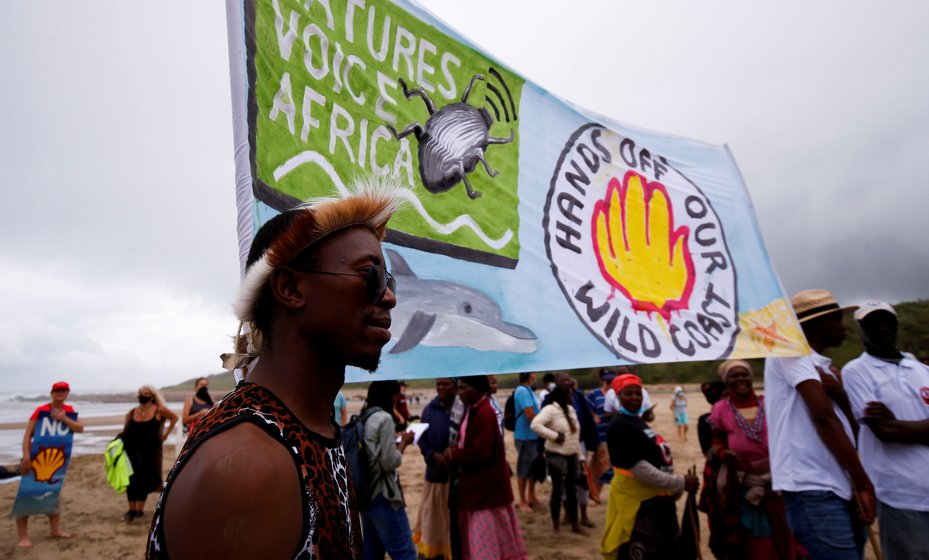
Residents join a demonstration against Royal Dutch Shell's plans to start seismic surveys to explore petroleum systems off the country's Wild Coast at Mzamba Beach, Sigidi, South Africa, December 5, 2021. Reuters/Rogan Ward
South Africa
Following one of the largest protests in post-apartheid South Africa in December 2021, Indigenous communities from the Wild Coast of South Africa’s Eastern Cape attained a landmark legal victory against energy and petroleum giant Shell. The Wild Coast falls within the Maputaland-Pondoland-Albany biodiversity hotspot, and as well as sustaining livelihoods, the ocean holds a significant cultural meaning for the Indigenous communities of the Eastern Cape.
The communities won the case at the South African High Court on the basis of violation of their constitutional right to be consulted and give consent to the project. The victory has been hailed as a major breakthrough in the effort to stem the tide of climate change, coming on the back of another 2021 Dutch court decision requiring Shell to reduce its reported worldwide emissions by 45% by the end of 2030. “It is not only about giving consent,” said Deputy Chair of local NGO Sustaining the Wild Coast, Sinegugu Zukulu, “It is about our right to say no to Shell directly and to be able to give our reasons".
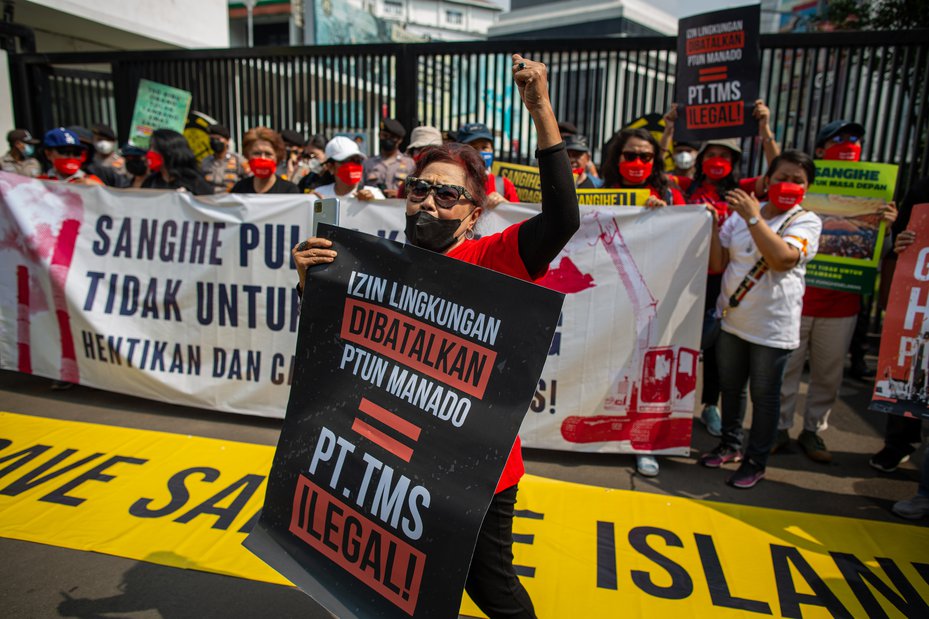
The Indigenous people of Sangihe Island and activists hold action against gold mining company PT. Tambang Mas Sangihe in front of The Ministry of Energy and Mineral Resources on Thursday, 7 July 2022. Afriadi Hikmal/Greenpeace
Indonesia
Sangihe Island communities
In May 2022, residents of Sangihe Island in Sulawesi province, Indonesia, won a lawsuit against a Canadian-backed company planning to mine gold on their island. A court ruled that the environmental permit issued to mining company PT Tambang Mas Sangihe for the proposed mine was invalid, and ordered local authorities to revoke the licence. At 42,000 hectares – an area more than half the size of New York City – the proposed mining site would cause widespread destruction. These concerns prompted 56 female villagers to file a lawsuit – ultimately successful – against the local authority government that issued the environmental permit.
The Sangihe villagers also filed a separate lawsuit at the state administrative court in Jakarta in which they sought the overall revocation of the mining contract.
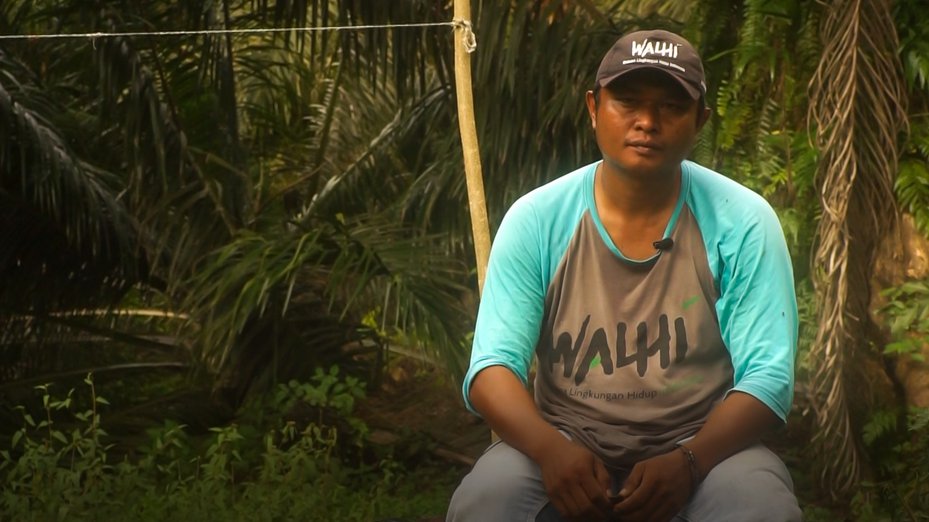
Franz Hemsi, farmer and land defender in Central Sulawesi, Indonesia, who successfully received recognition of his rights to 20 of 50 hectares of land that had been illegitimately and violently grabbed. WALHI/Friends of the Earth Indonesia
Franz Hemsi
Earlier this year, after 15 years of battling a palm oil company that violently grabbed his land, Indonesian farmer and land defender Franz Hemsi received recognition of his rights over 20 hectares. Hemsi has fought relentlessly against PT Mamuang, a subsidiary of Astra Agro Lestari – Indonesia’s second largest palm oil company – since it forcibly took over his land in 2005. The company has reportedly been embroiled in protracted land conflicts with local farmers. Hemsi was imprisoned three times and he and his family were subjected to regular threats. He has now received recognition of his rights over 20 of the 50 hectares the company tried to take due to his tireless resistance, the backing of his community, and legal support and advocacy targeting the financiers of Astra Agro Lestari.
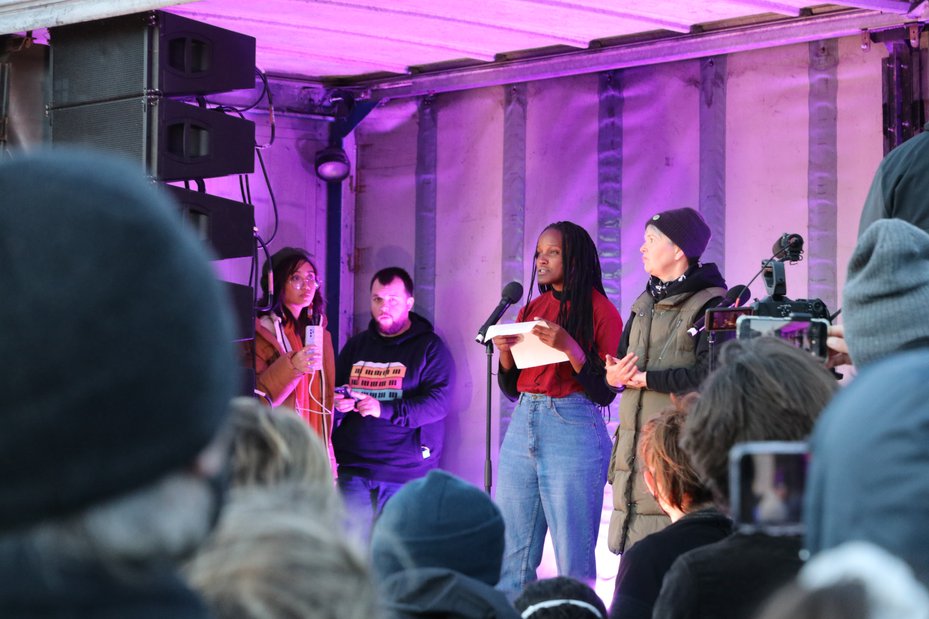
Vanessa Nakate, climate justice activist from Uganda, speaks at a climate justice rally and march organised by the COP26 Coalition took place in Glasgow, UK, on 6 November 2021. Jasmin Qureshi/Global Witness
Urgent actions are needed to hold companies and governments to account for the violence, criminalisation and other attacks faced by land and environmental defenders, who are often standing on the frontline of the climate crisis. The following actions must be taken by governments and businesses to tackle the key drivers and enablers of attacks against defenders:
Governments should:
- Create a safe environment for defenders and civic space to thrive: Existing laws that protect defenders must be enforced. Where such laws do not exist, new frameworks must be established. And efforts to use any legislation to criminalise defenders should be declared null and void. Governments must protect defender rights, including rights to free, prior and informed consent, Indigenous peoples’ rights to their livelihood and culture, the right to life, liberty and freedom of expression, and the right to a safe, healthy and sustainable environment. These are basic human rights, which are already embodied in various laws, including national constitutions. In addition, relevant existing mechanisms and tools should be used to better protect defenders and promote civic space, including the Escazú Agreement, the UN Special Rapporteur procedures, and the Esperanza Protocol.
- Promote legal accountability of companies: Require companies and financial institutions to carry out due diligence on human rights and environmental risks throughout their global operations (including supply chains and business relationships), promoting transparency and accountability for violence and other harms to land and environmental defenders. Corporate accountability laws must uphold the standards set out in the UN Guiding Principles on Business and Human Rights.
Businesses should:
- Identify, prevent, mitigate and remedy any harms in their operations against defenders: Implement robust due diligence procedures that seek to prevent, identify, mitigate and account for human rights and environmental harms throughout their operations. Company policies must explicitly include protocols for safeguarding the rights of land and environmental defenders. Businesses must swiftly provide remedies where human rights and environmental harms occur.
- Ensure legal compliance and corporate responsibility at all levels: Strictly implement a policy of zero-tolerance on reprisals and attacks on land and environmental defenders, illegal land acquisition and violations of the right of free, prior and informed consent at all levels of business operations, including in their global operations, supply chains and business relationships. These policies should state who at the senior level will be responsible for legal compliance, as well as how it will be implemented and monitored, and clear red lines for prompt suspension or termination of contracts for non-compliant suppliers.
Governments and businesses should:
- Implement a rights-based approach for addressing climate change: Ensure commitments to implement the Paris Agreement align with existing international human rights obligations and standards, and promote just and equitable solutions to climate change. This should include strengthening the land rights of Indigenous and traditional communities, and enhancing their participation in decision-making in recognition of the key role they play in protecting the world’s last remaining biodiverse areas.
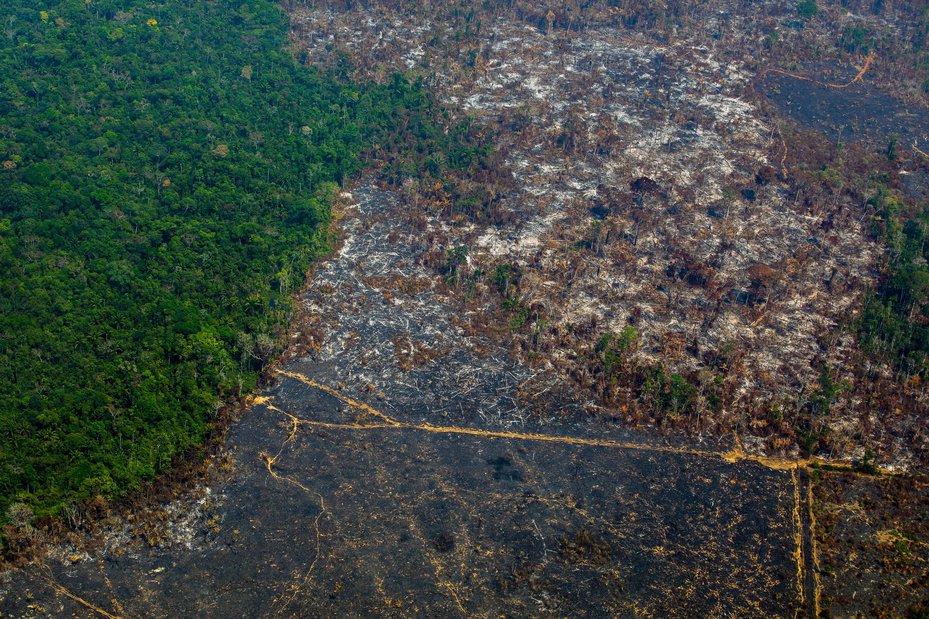
Aerial view of deforestation in Nascentes da Serra do Cachimbo Biological Reserve in Altamira, Para state, Brazil. Joao Laet/AFP via Getty Images
EU must take the lead on corporate responsibility
In February 2022, the European Commission released a draft law to promote corporate accountability by requiring companies to assess their impacts on people and the planet. The Corporate Sustainability Due Diligence Directive – if passed – will require companies operating in the EU to conduct due diligence to identify, prevent and mitigate human rights and environmental risks associated with their activities, and remedy harms that they have caused. If passed, this law could be the first regional framework obliging companies to act sustainably. Crucially, it could also hold them liable in European courts if they fail to comply.
Despite its potential, several components of the proposed law must be strengthened for it to ensure greater corporate accountability. The published draft does not recognise land and environmental defenders, including Indigenous peoples, as vital actors with whom companies need to engage continuously – with the draft merely stating that they should be consulted only “where relevant”. With growing violence against defenders, it is essential that the legislation mandates meaningful engagement with impacted and potentially impacted communities as part of a company’s ongoing due diligence processes.
Additionally, the current proposal appears to provide a free pass to the financial sector without any justification. Financial institutions, such as investors, insurers and banks, would face minimal due diligence requirements compared to other companies covered by the Directive. Global Witness has exposed the role that EU-based financiers and their subsidiaries overseas have played in supporting projects that have caused human rights violations and environmental damage – including land grabbing, deforestation, corruption and violence against land and environmental defenders. Like other companies subject to the EU law, financial institutions must also be required to identify, prevent and mitigate risks to people and the planet.
Finally, with the IPCC warning of “a brief and rapidly closing window of opportunity” to tackle the climate crisis, the Directive must include a binding climate due diligence framework. Businesses have played a central role in creating the climate crisis, yet action from the international community to curb harmful corporate behaviour has been slow and insufficient. Extending the Directive to include climate due diligence will ensure business models transition to a sustainable economy, and that companies reduce their global gas emissions to meet the 1.5°C climate target.
Recommendations to the European Union
As a major trading bloc with a global footprint, the European Union has the responsibility and opportunity to lead the way on corporate accountability. It is obliged to contribute to protecting human rights and the environment, particularly where the Union's actions have an international impact. Specifically, the EU should ensure that the Corporate Sustainability Due Diligence initiative:
- Requires that companies engage with affected Indigenous and local communities and other land and environmental defenders in a safe, meaningful and inclusive way.
- Requires that financial institutions be held to internationally recognised due diligence standards, including conducting ongoing due diligence, safely disengaging from harmful business relationships where harm cannot be prevented, and conducting due diligence on business partners based on risk (rather than partner company size).
- Requires that companies conduct effective climate due diligence in line with proposed human rights and environmental due diligence requirements.
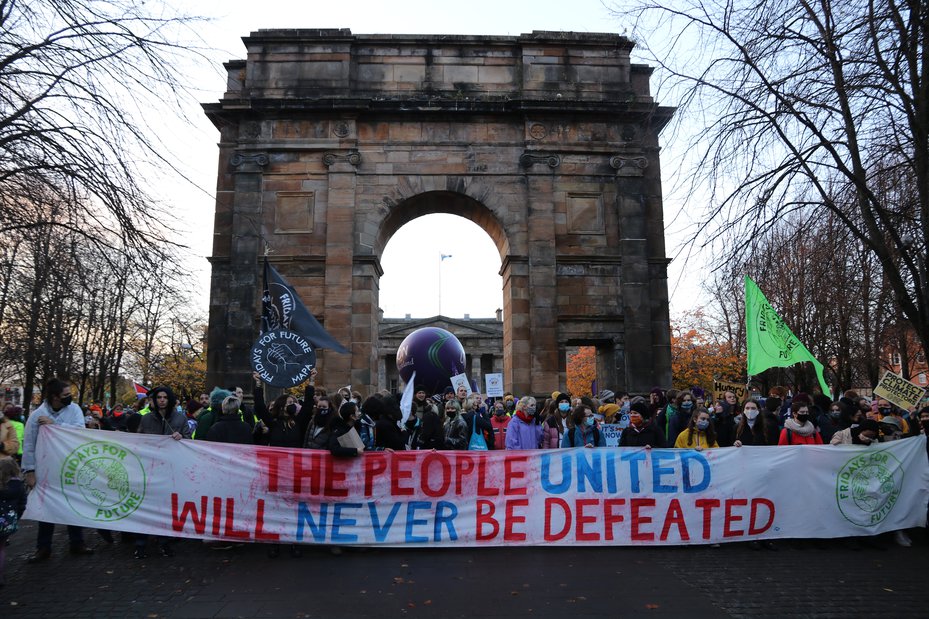
A climate justice rally and march organised by the COP26 Coalition took place in Glasgow, UK, on 6 November 2021. This was part of the Global March for Climate Justice, with actions happening across the world. Jasmin Qureshi/Global Witness
The Global Witness Land and Environmental Defenders Campaign aims to stop the broad range of threats and attacks that land and environmental defenders and their communities face. It strives to raise awareness of these abuses and to amplify the voices of defenders in support of their work and that of their networks.
We define land and environmental defenders as people who take a stand and carry out peaceful action against the unjust, discriminatory, corrupt or damaging exploitation of natural resources or the environment. Land and environmental defenders are a specific type of human rights defender – and are often the most targeted for their work.
Our definition covers a broad range of people. Defenders often live in communities whose land, health and livelihoods are threatened by the operations of mining, logging, agribusiness companies or other industries. Others will be defending our biodiverse environment. Others will be supporting such efforts through their work – as human rights or environmental lawyers, politicians, park rangers, journalists, or members of campaigns or civil society organisations, for instance.
Global Witness has produced a yearly account of murdered land and environmental defenders since 2012. We maintain a database of these killings so that there is a record of these tragic events and we can track trends and highlight the key issues behind them.
Research into the killings and enforced disappearances of land and environmental defenders between 1 January 2021 and 31 December 2021
Global Witness identifies cases of killings by searching and reviewing reliable sources of publicly available online information, through the following process:
- We identify datasets from international and national sources with details of named human rights defenders killed, such as the Frontline Defenders annual report and the Programa Somos Defensores annual report on Colombia, and then research each case.
- We set up search-engine alerts using keywords and conduct other searches online to identify relevant cases across the world.
- Where possible or necessary, we check with in-country or regional partners to gather further information on the cases. We work with approximately 30 different local, national and regional organisations across over 20 countries to do this.
To meet our criteria, a case must be supported by the following available information:
- Credible, published and current online sources of information.
- Details about the type of act and method of violence, including the date and location.
- Name and biographical information about the victim.
- Clear, proximate and documented connections to an environmental or land issue.
Sometimes we will include a case that does not meet the criteria outlined above, where a respected local organisation provides us with compelling evidence that is not available online, based on their own investigations.
Global Witness includes friends, colleagues and the family of murdered land and environmental defenders in its database if a) they appear to have been murdered as a reprisal for the defender’s work, or b) they were killed in an attack that also left the defender dead.
Global Witness also records forced disappearances of land and environmental defenders, checking each case for an update a minimum of six months after the disappearance. In cases where the individual remains disappeared, it is recorded as a killing.
Our data on killings is likely to be an underestimate, given that many murders go unreported, particularly in rural areas and in particular countries.Our set of criteria can’t always be met by a review of public information like newspaper reports or legal documents, nor through local contacts - having this strict methodology therefore means our figures do not represent the scale of the problem, and we are constantly working to improve this.
In summary, the figures presented in this report should be considered as only a partial picture of the extent of killings of land and environmental defenders across the world in 2021. We identified relevant cases in 17 countries in 2021, but it is likely that attacks affecting land and environmental defenders also occurred in other countries where human rights violations are widespread. Reasons why we may not have been able to document such cases in line with our methodology and criteria include:
- Limited presence of civil society organisations, NGOs and other groups monitoring the situation.
- Government suppression of the media and other information outlets.
- Wider conflicts and/or political violence, including between communities, that make it difficult to identify specific cases.